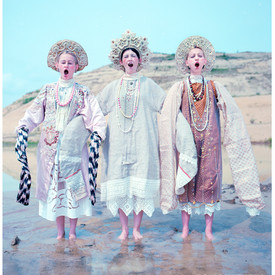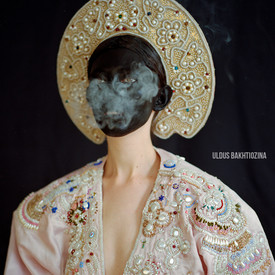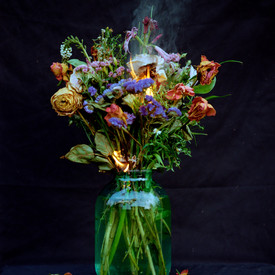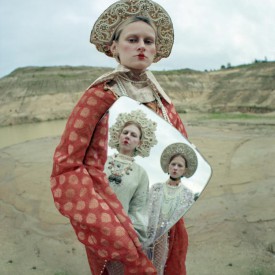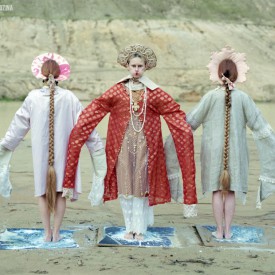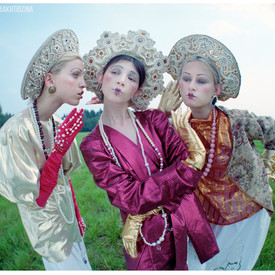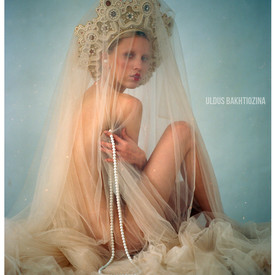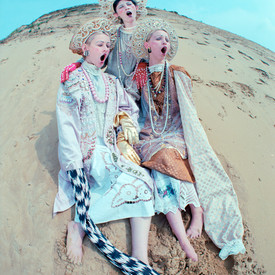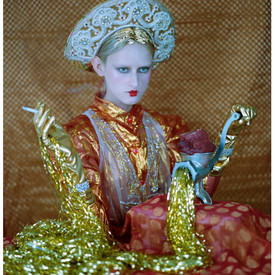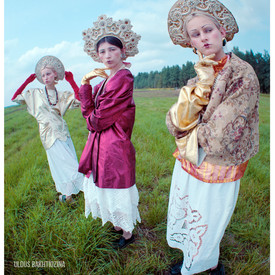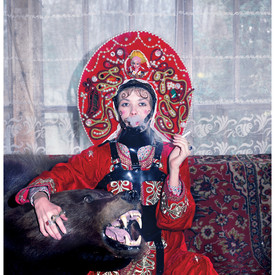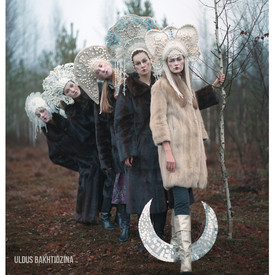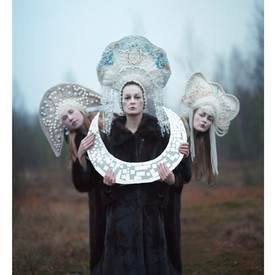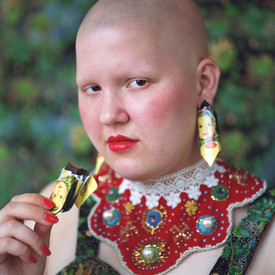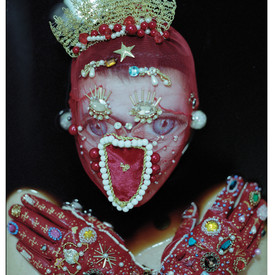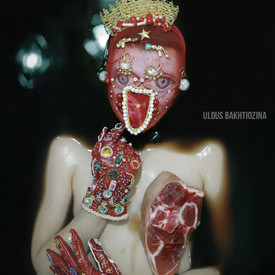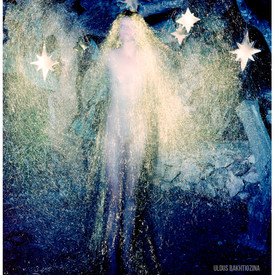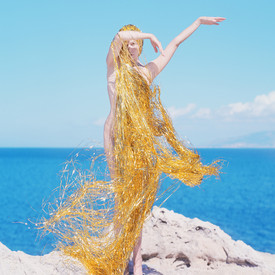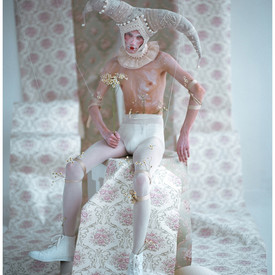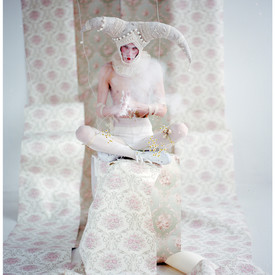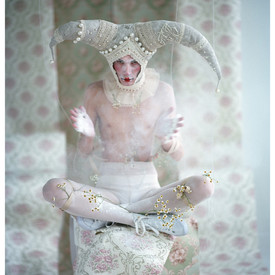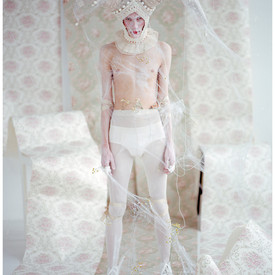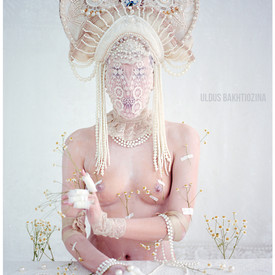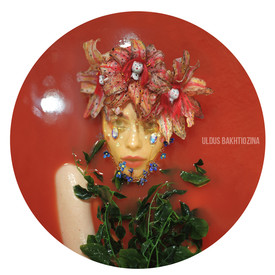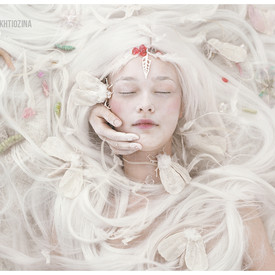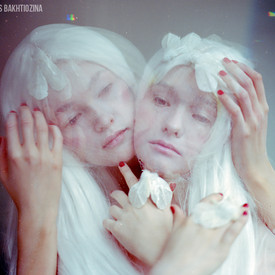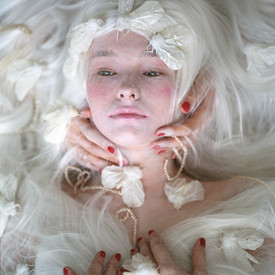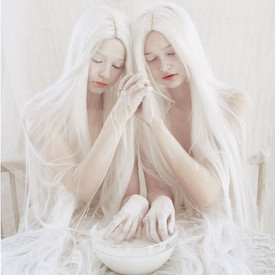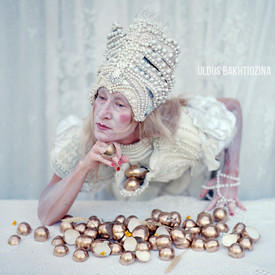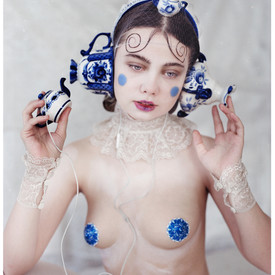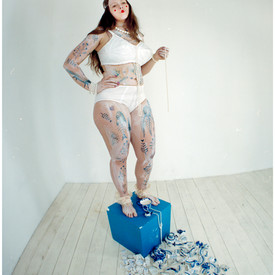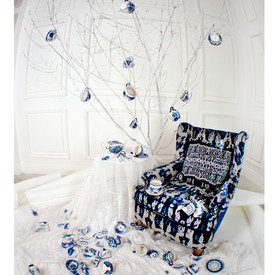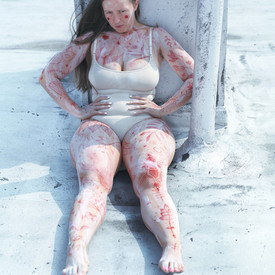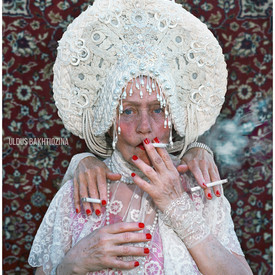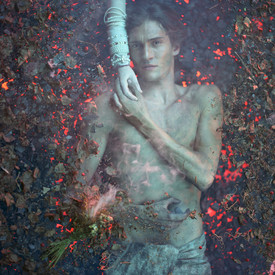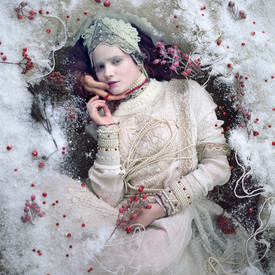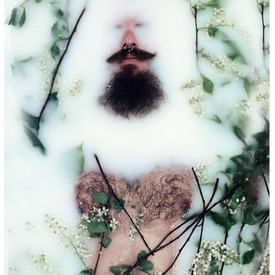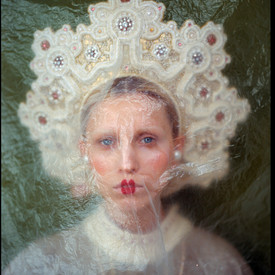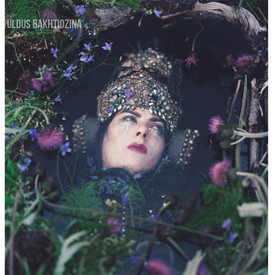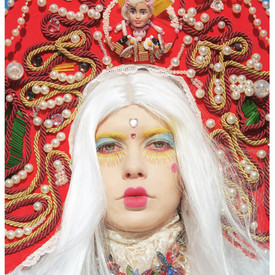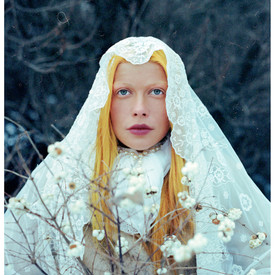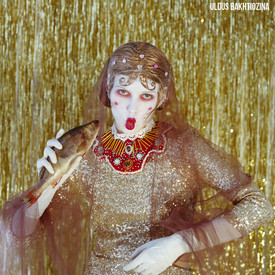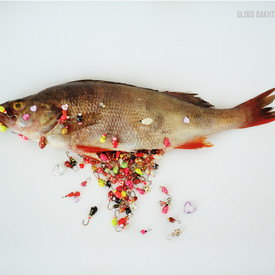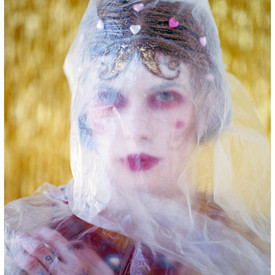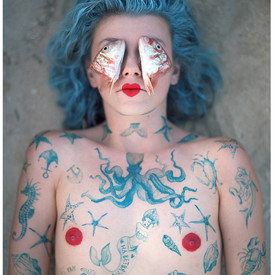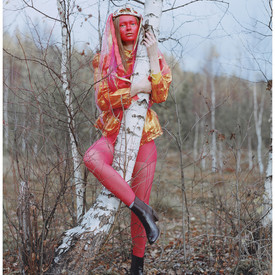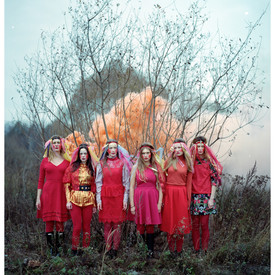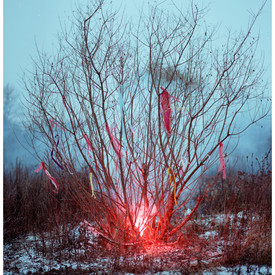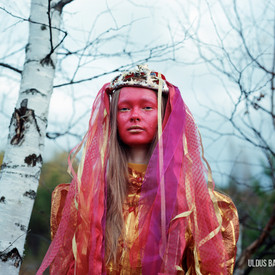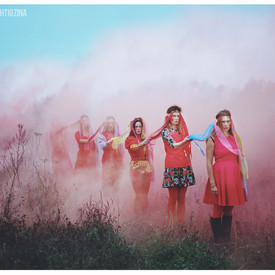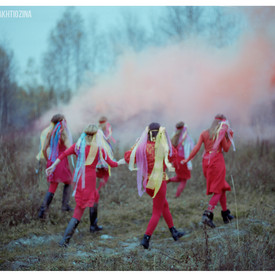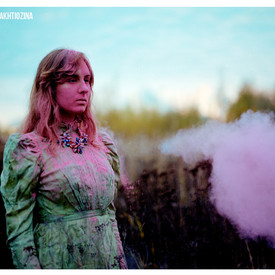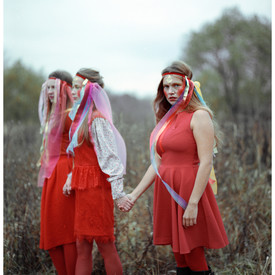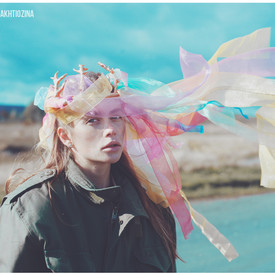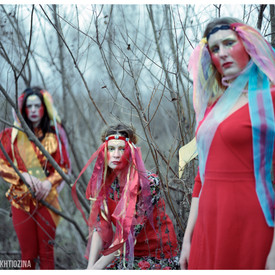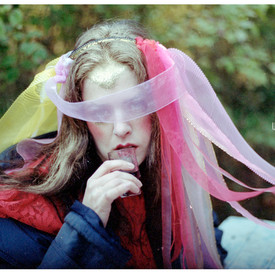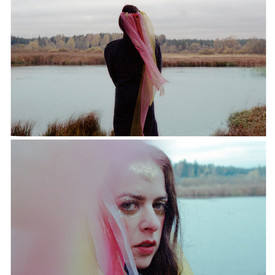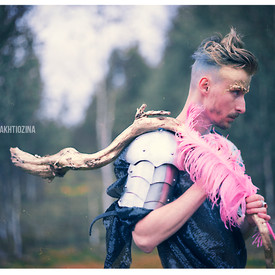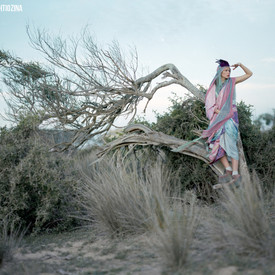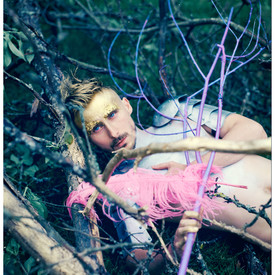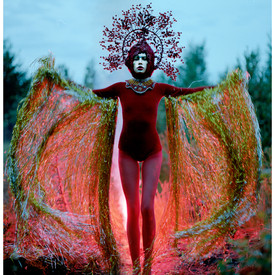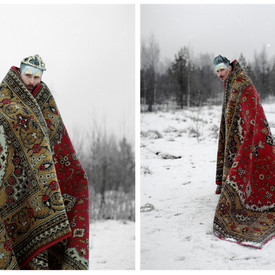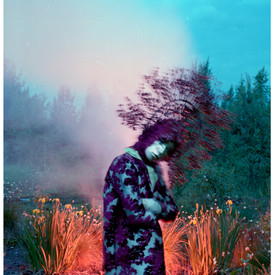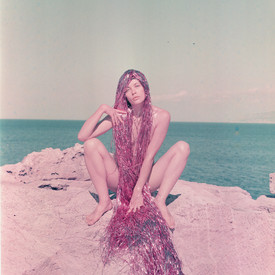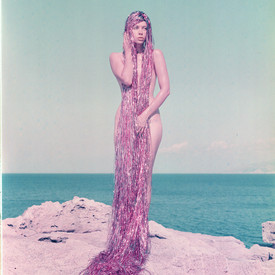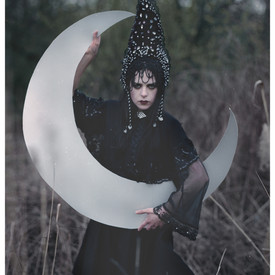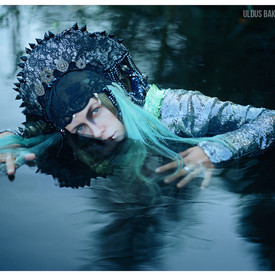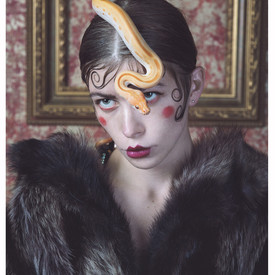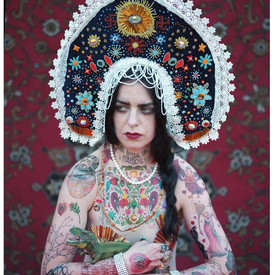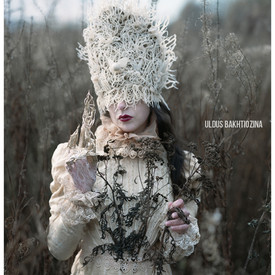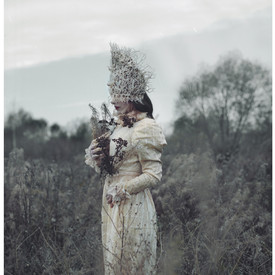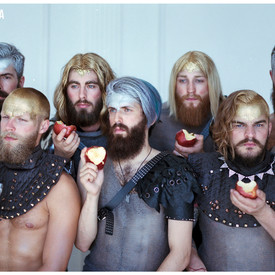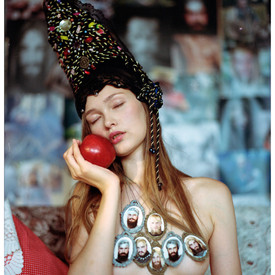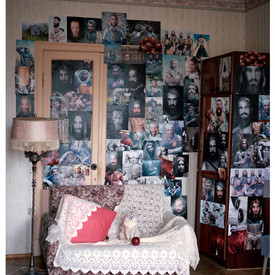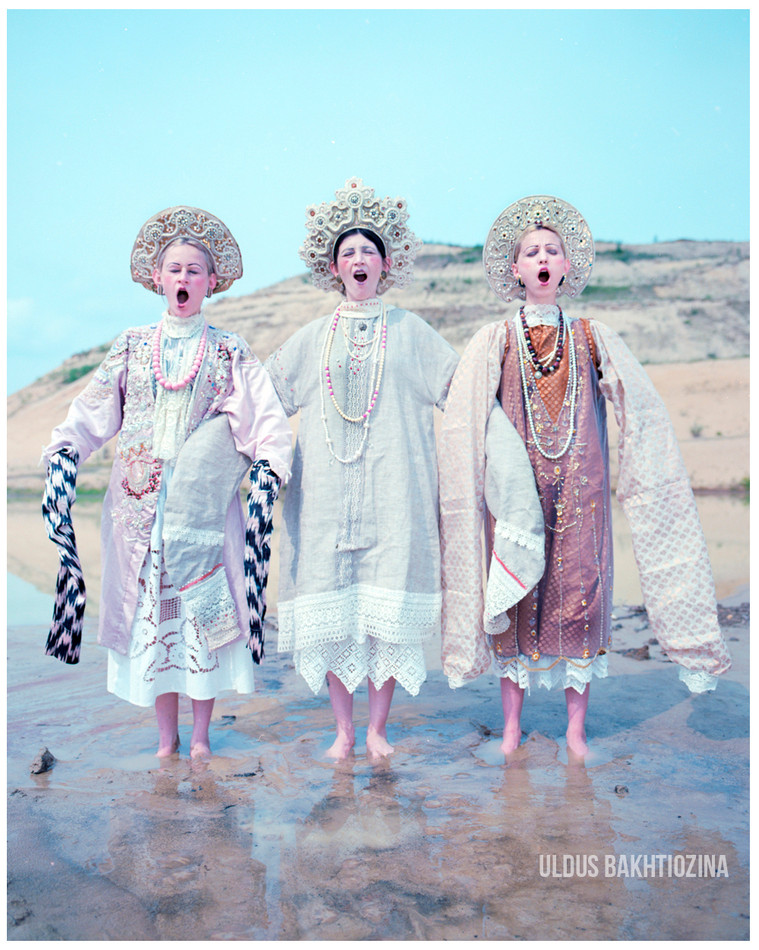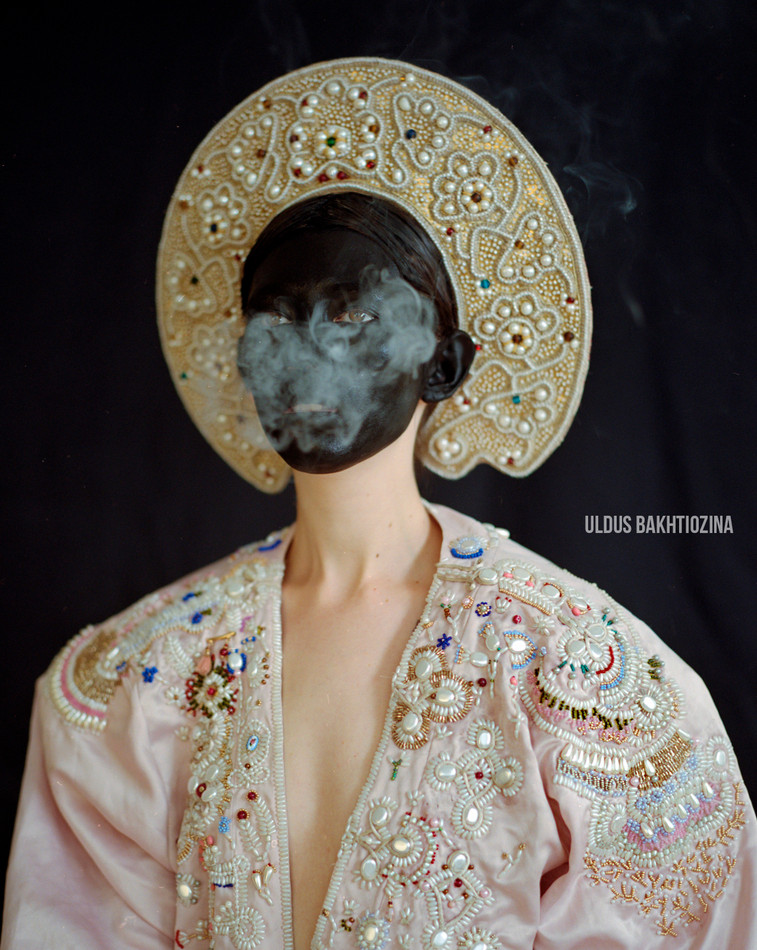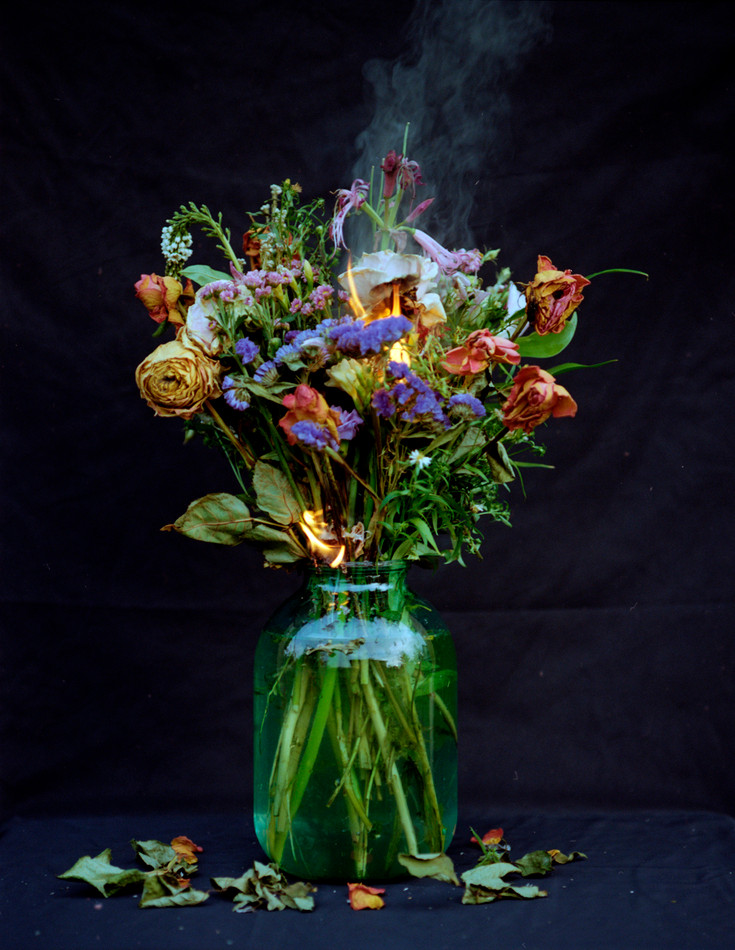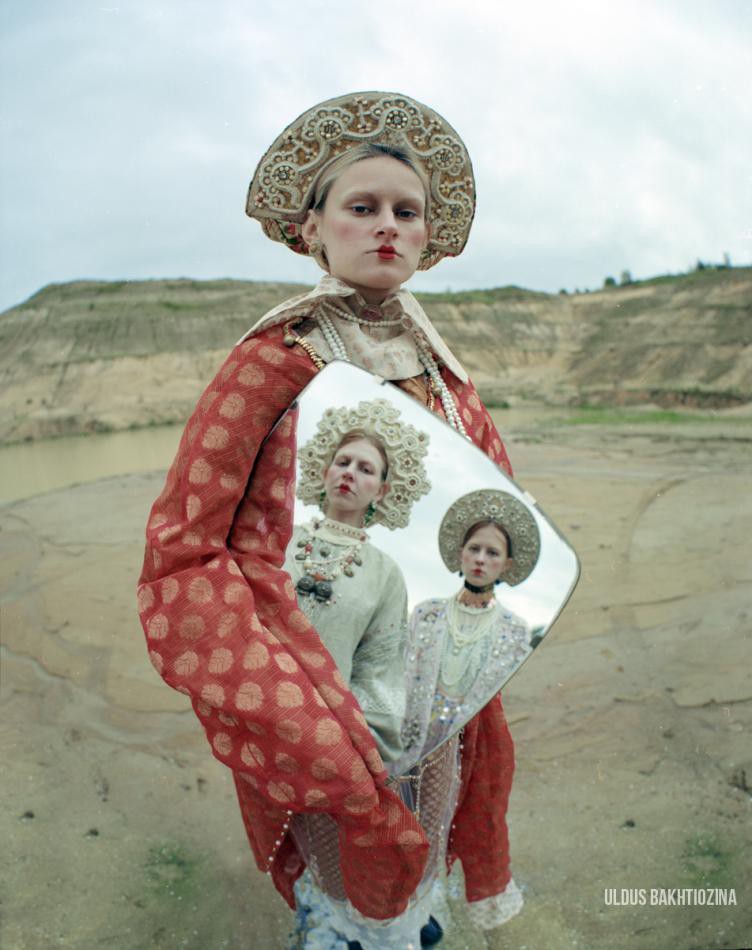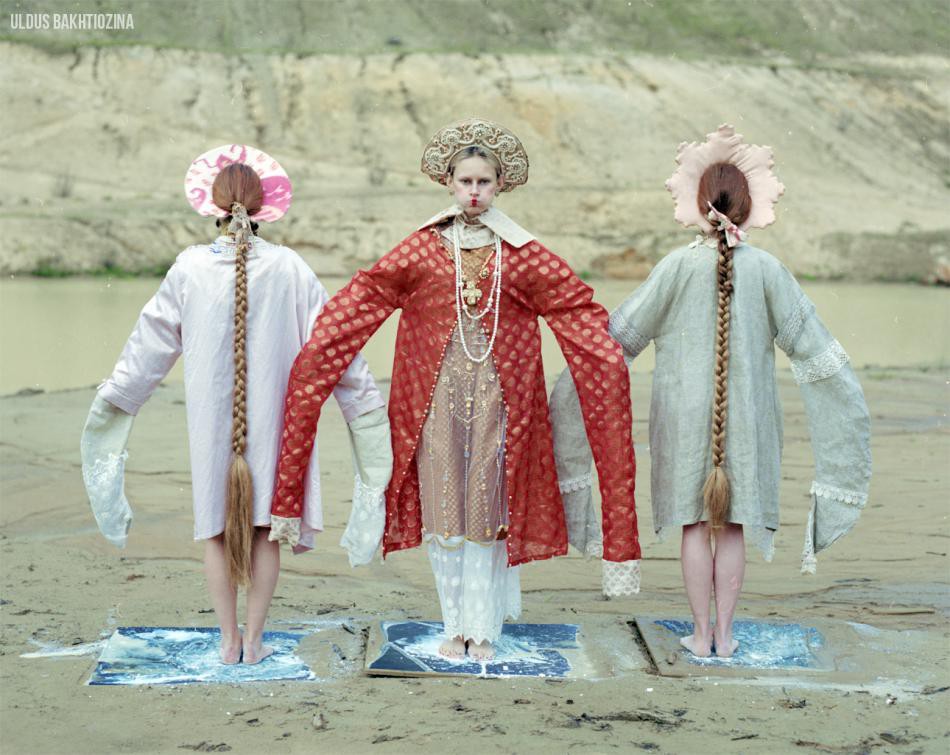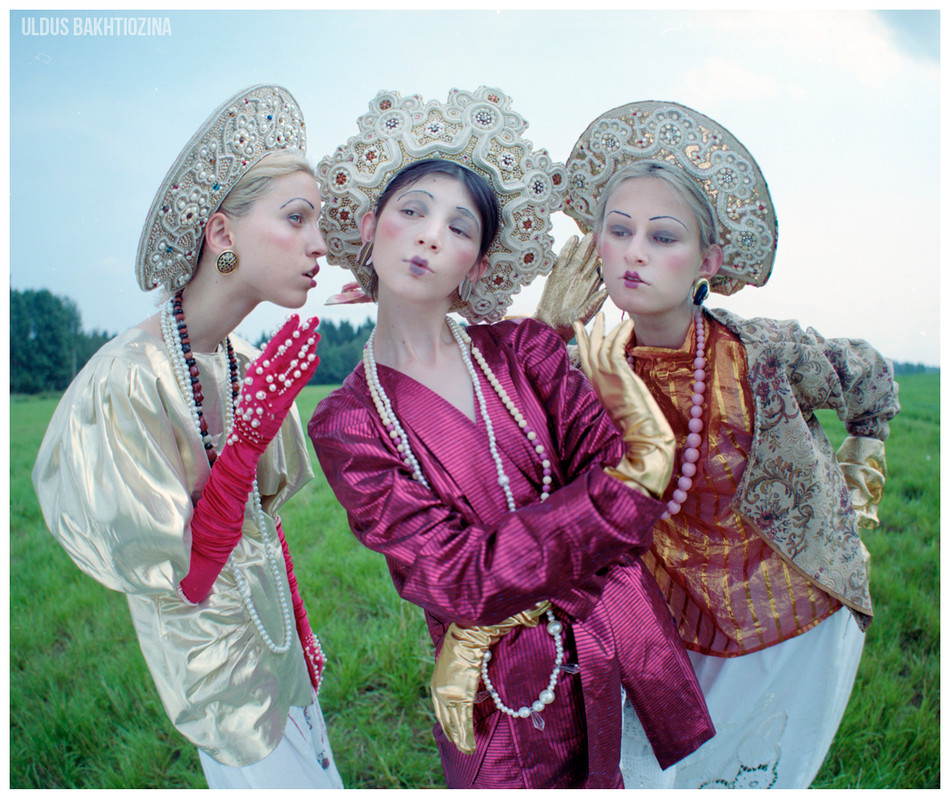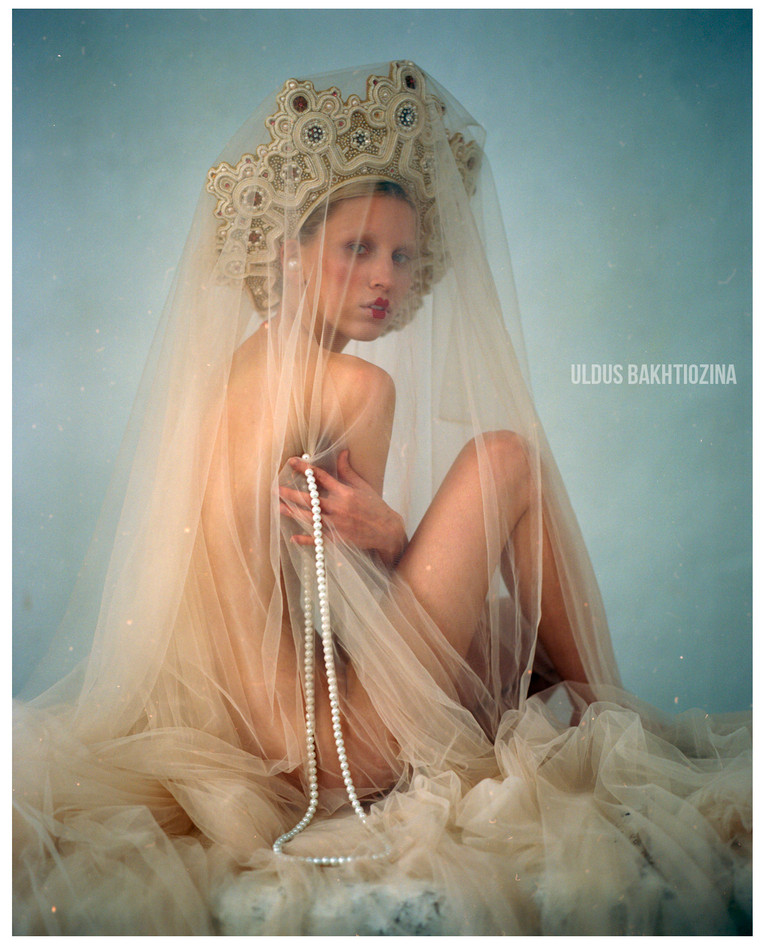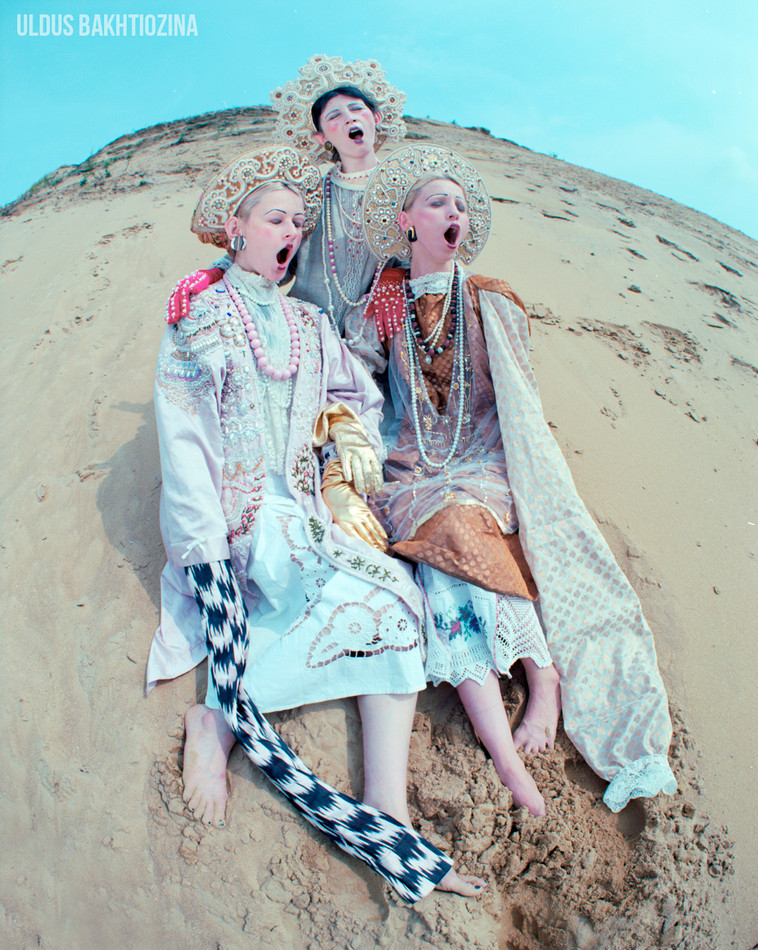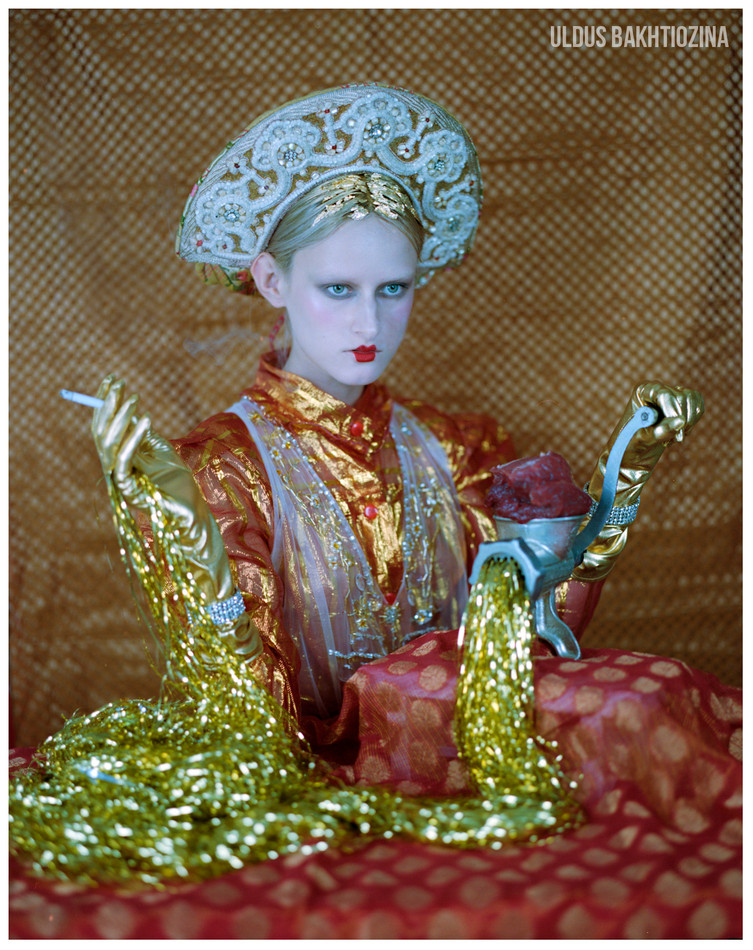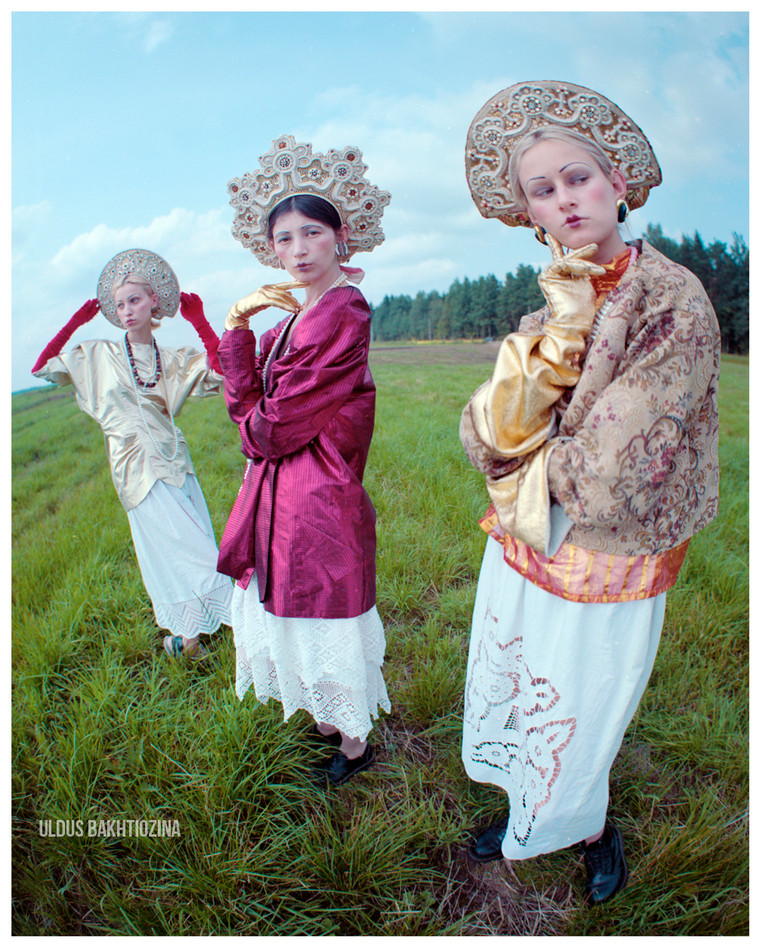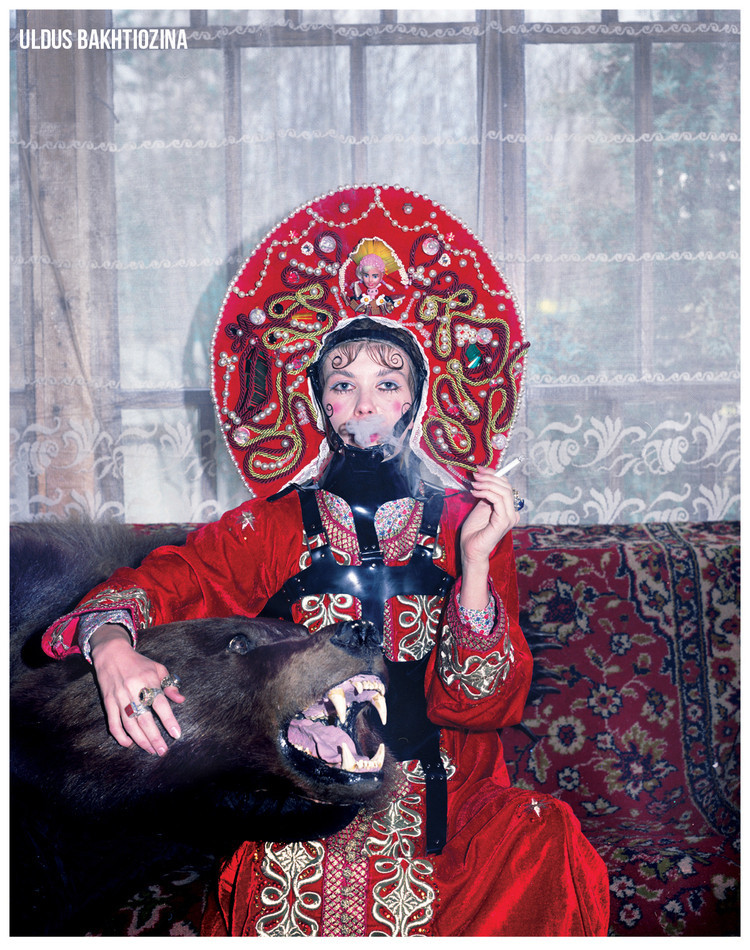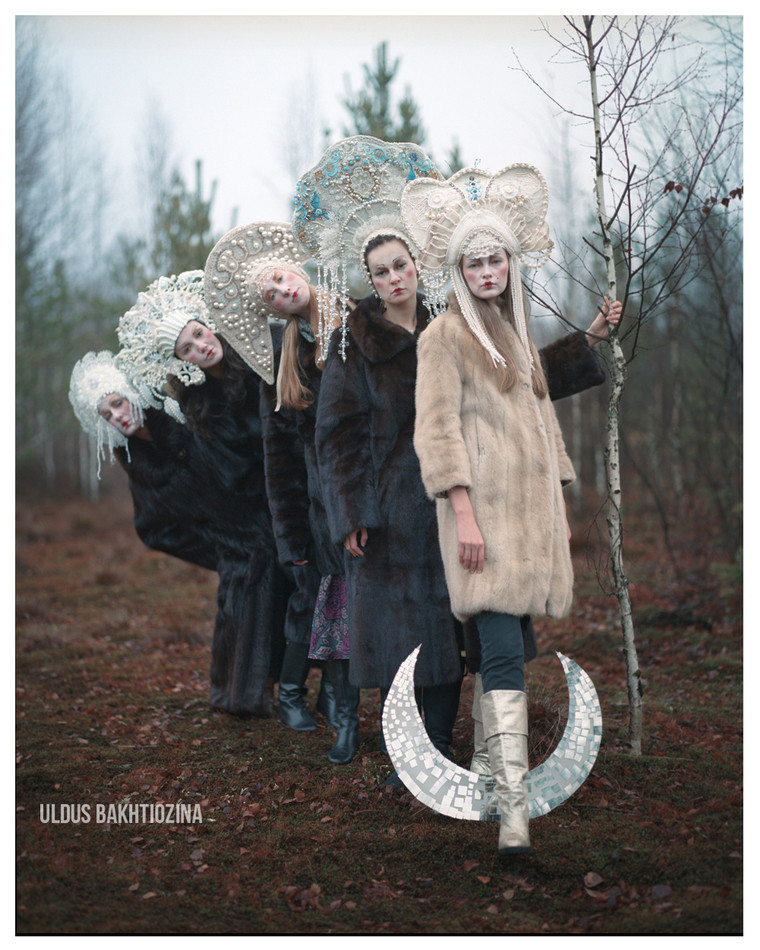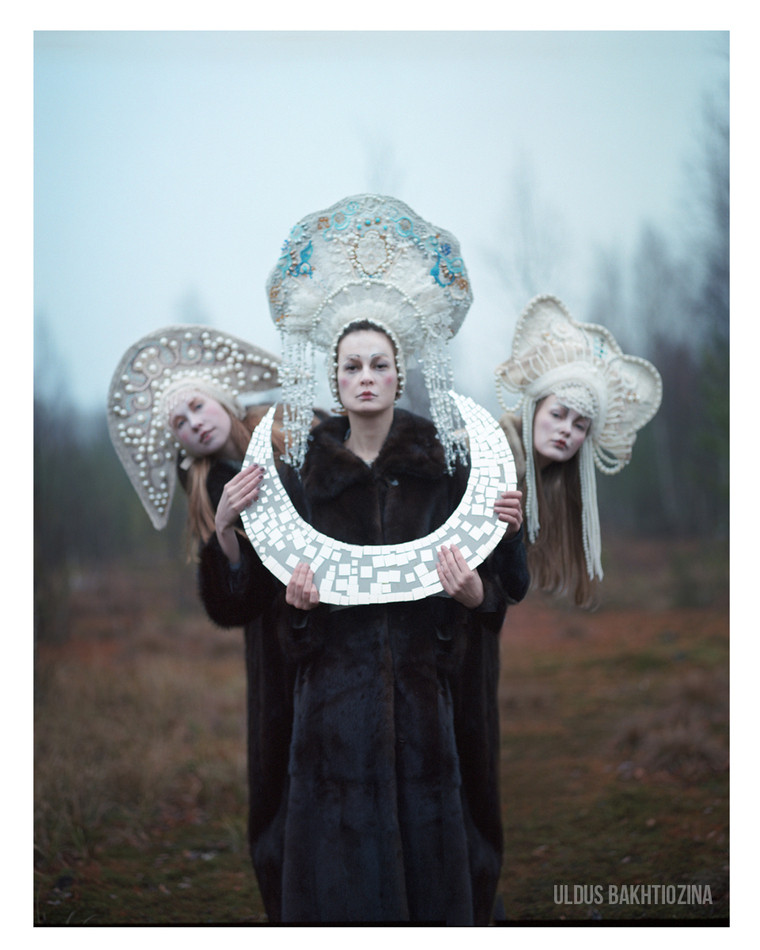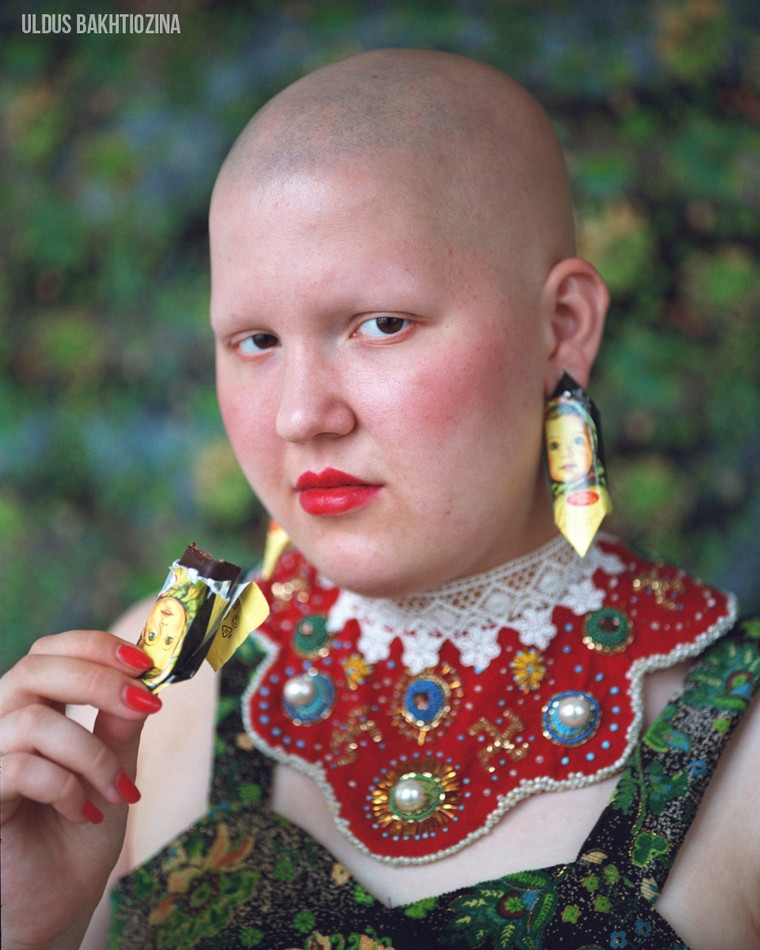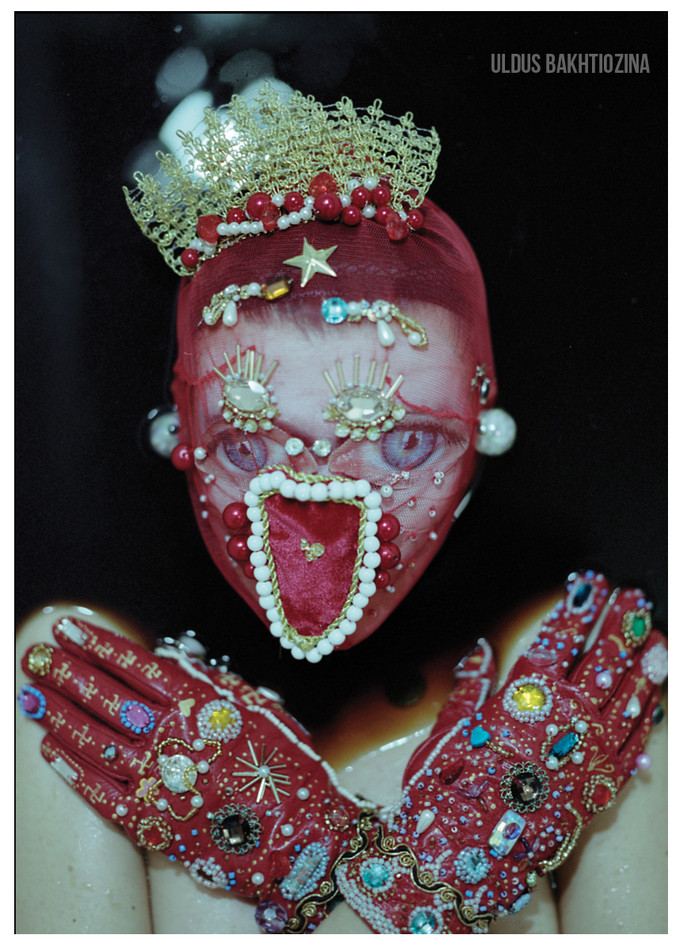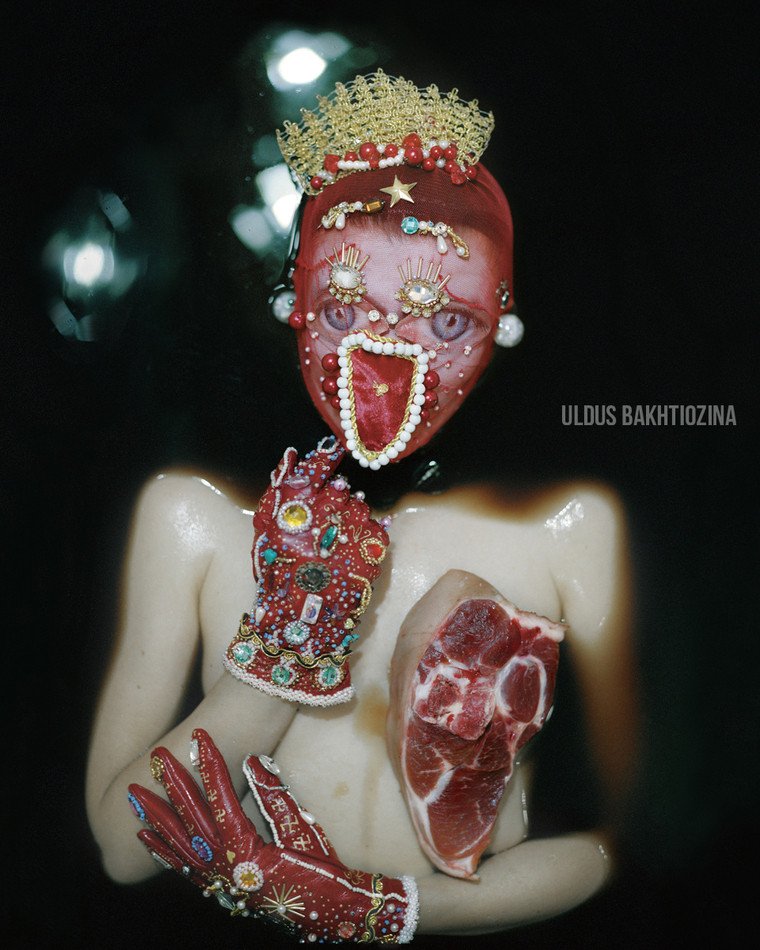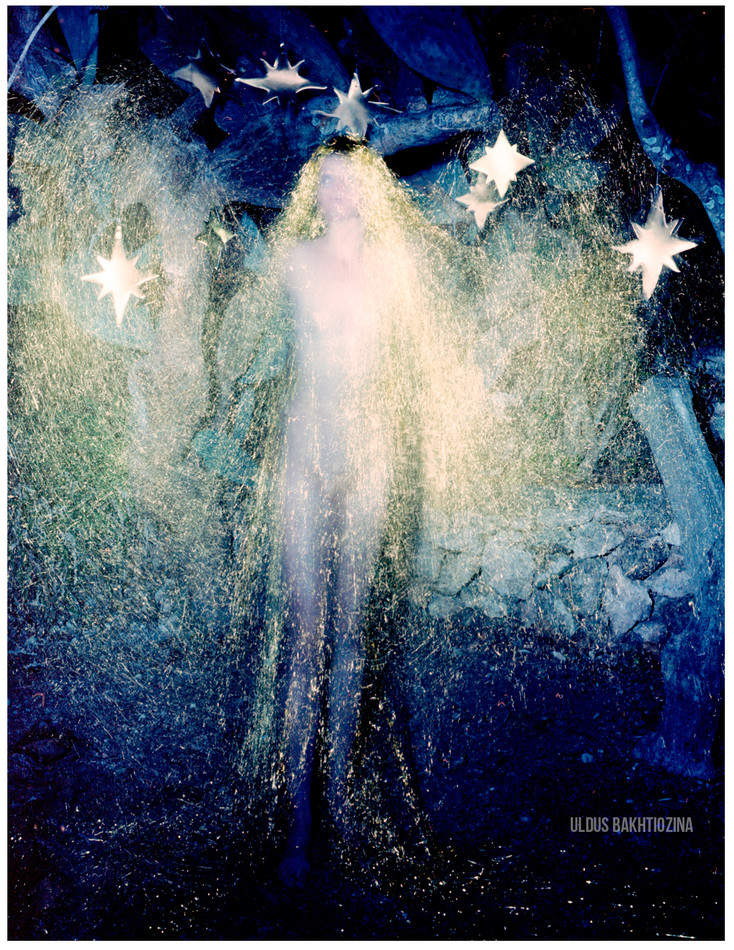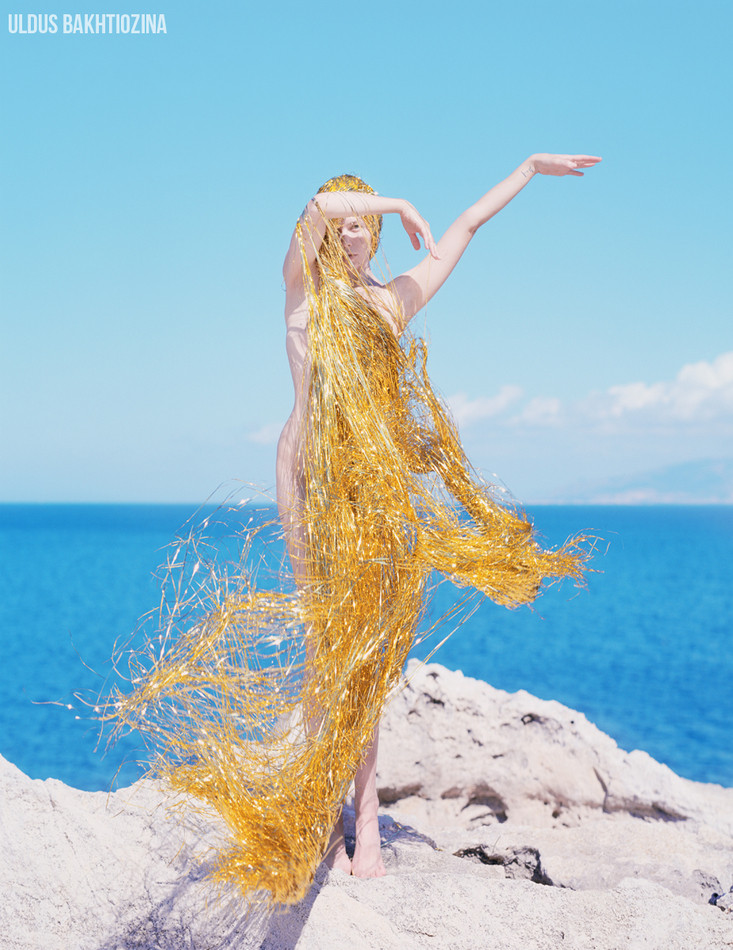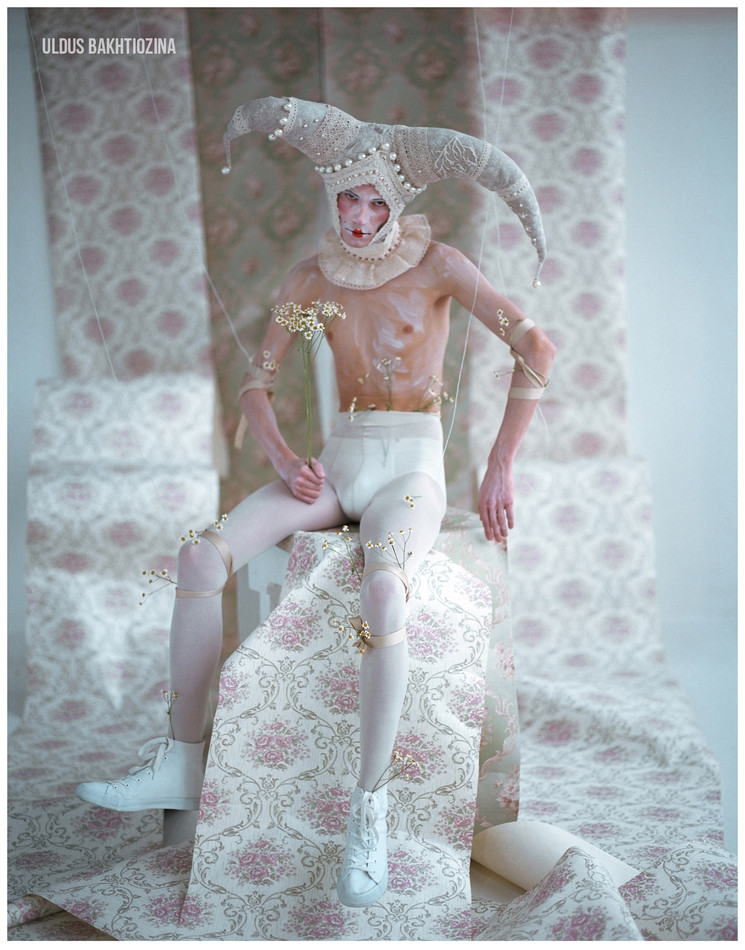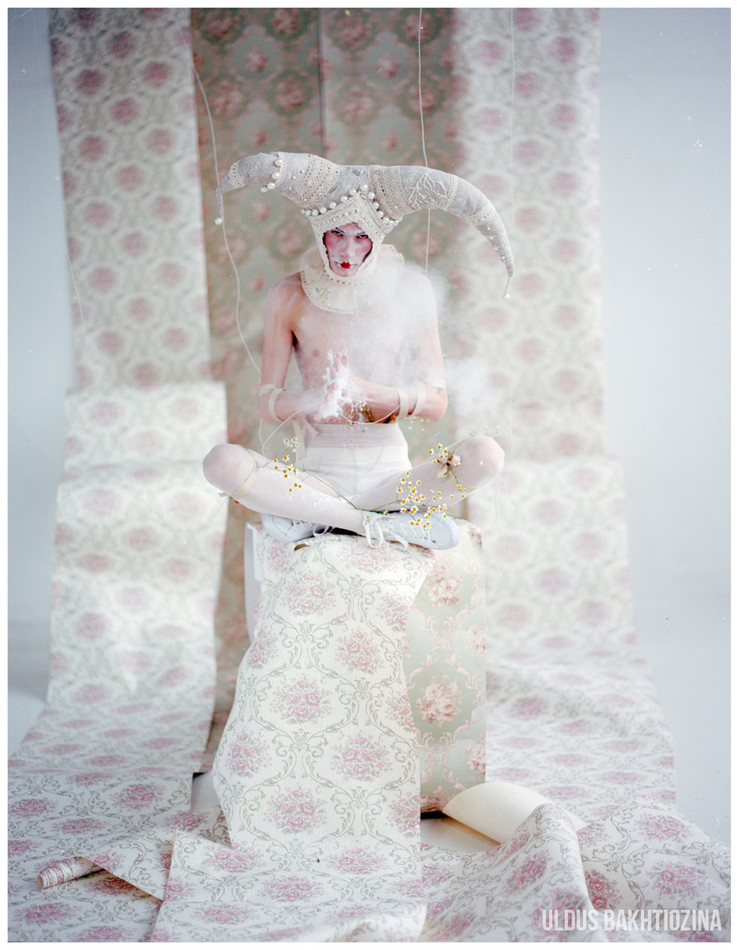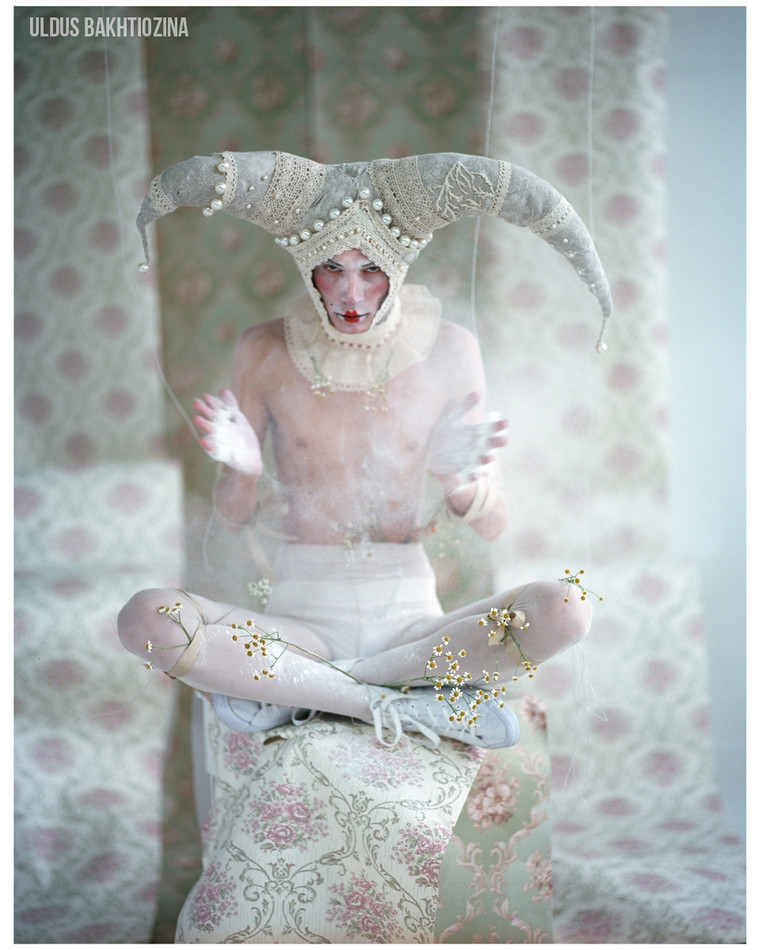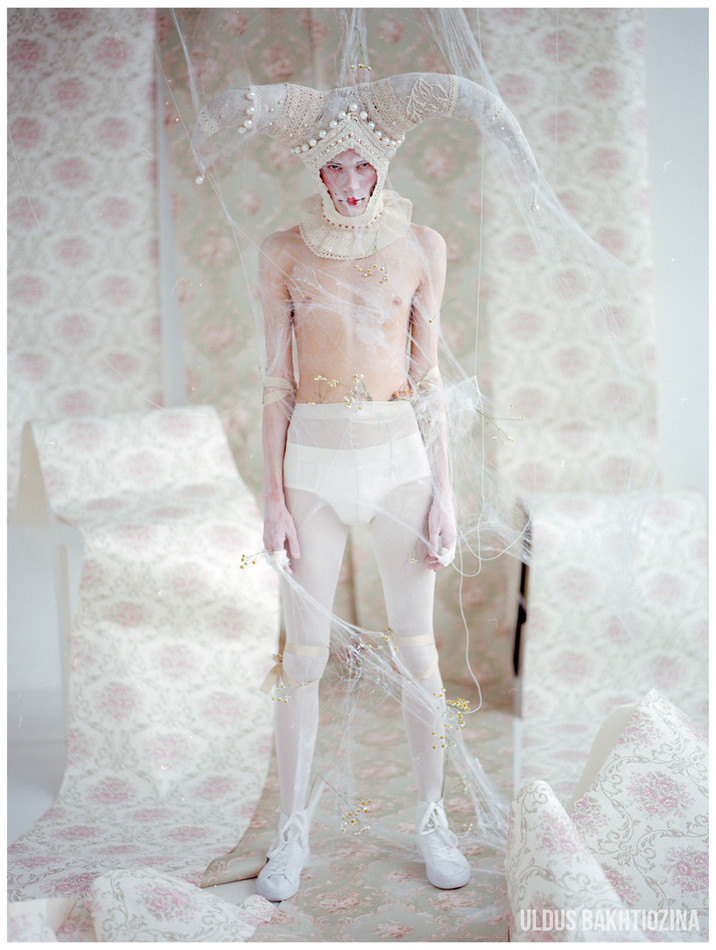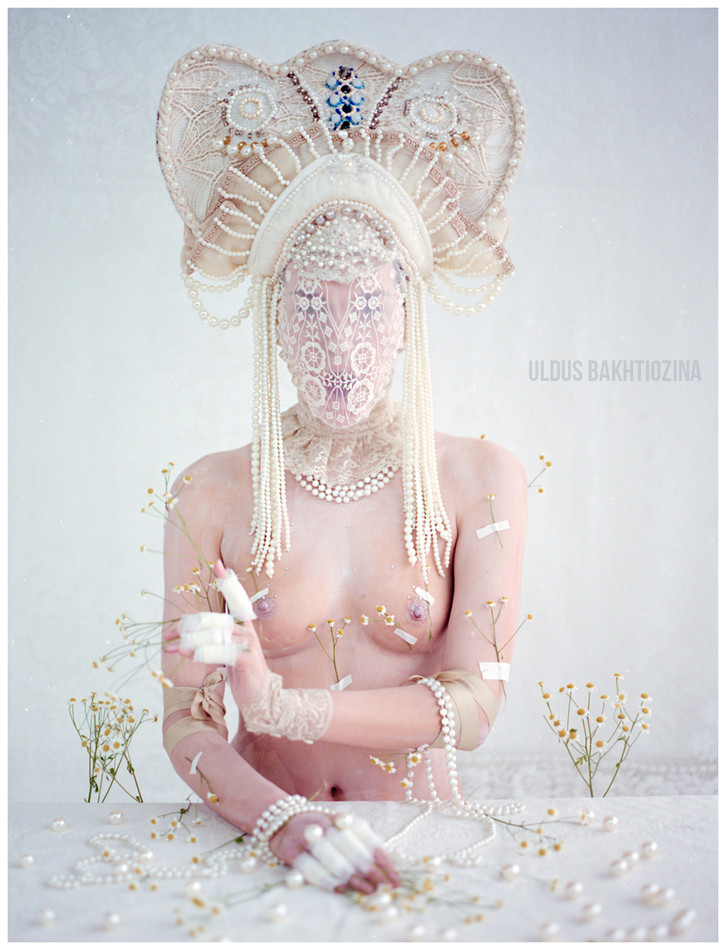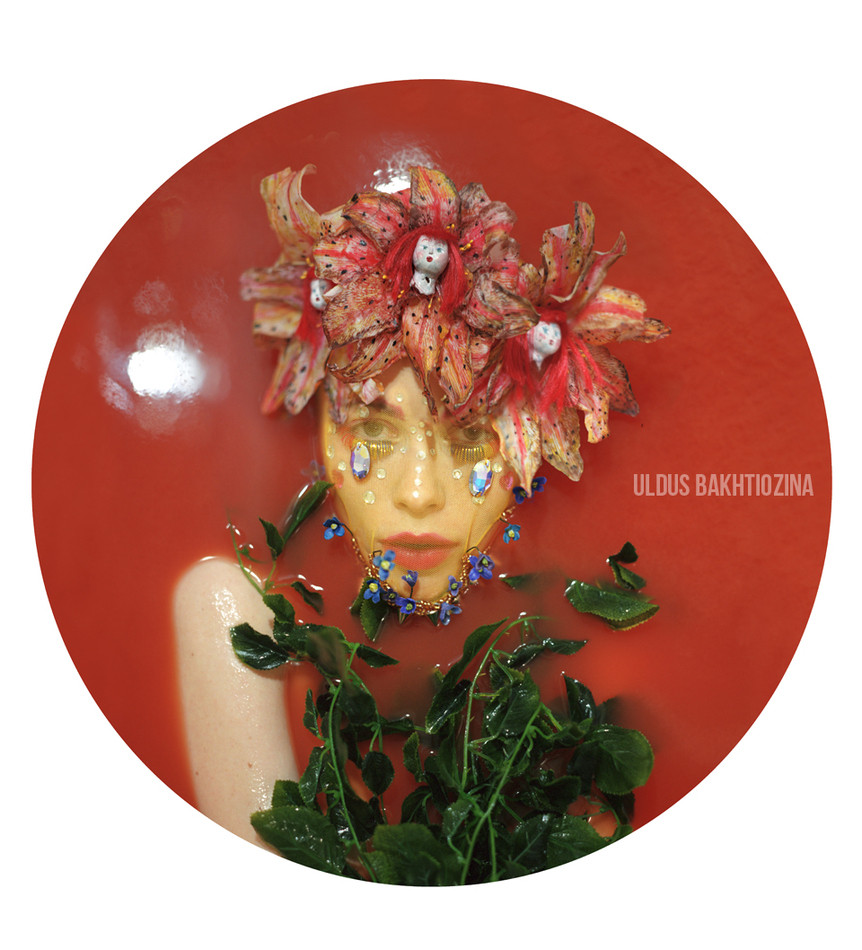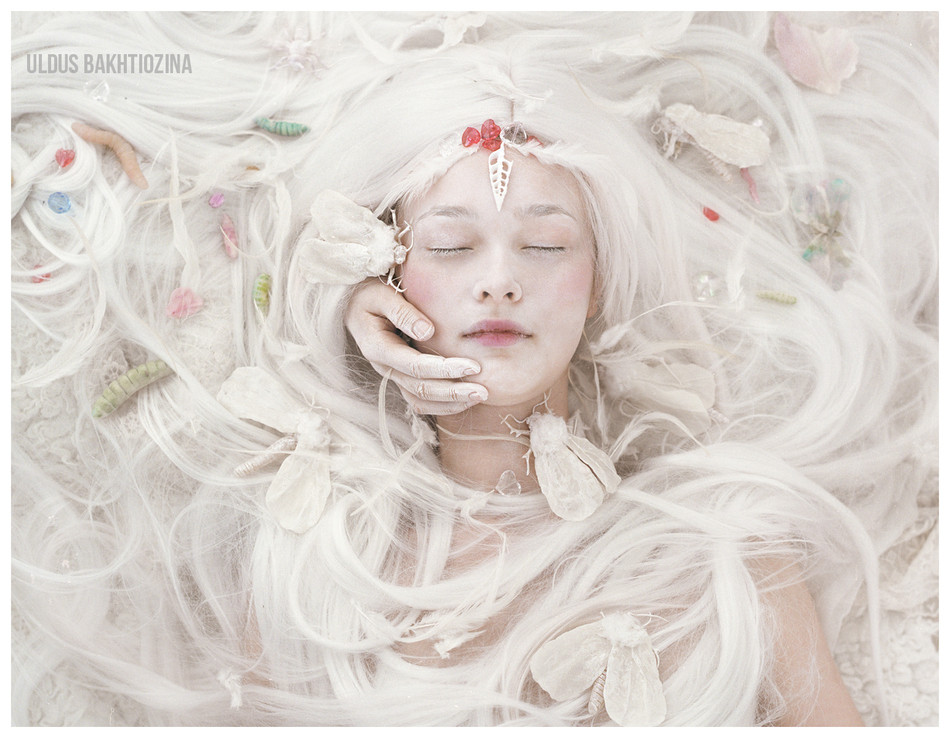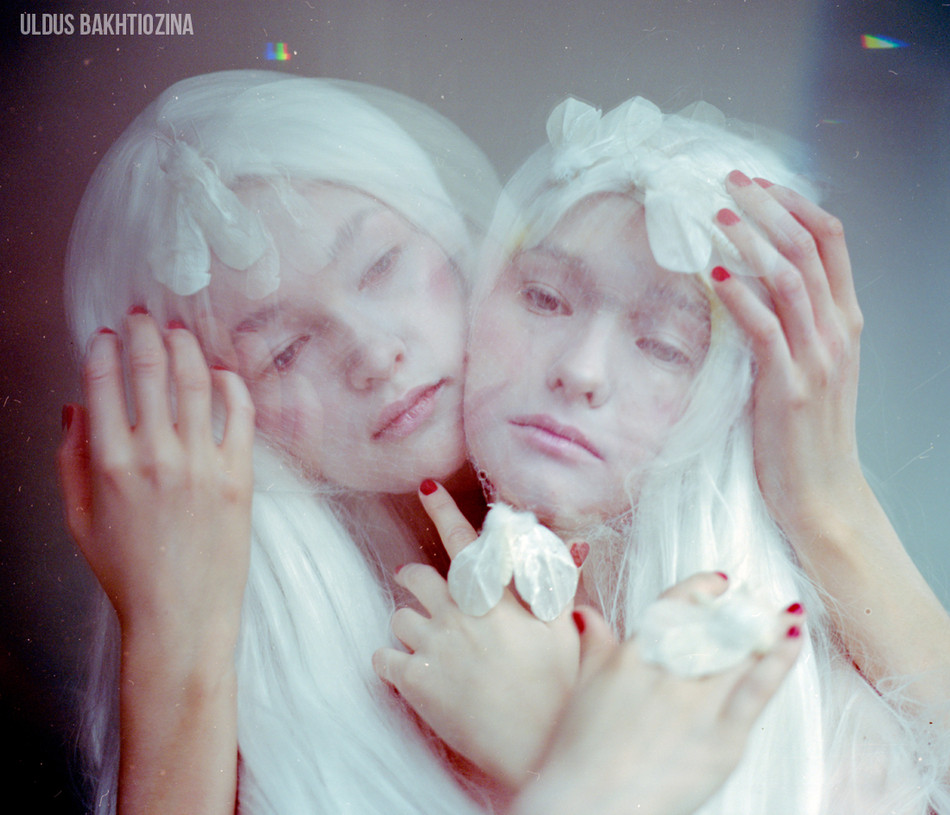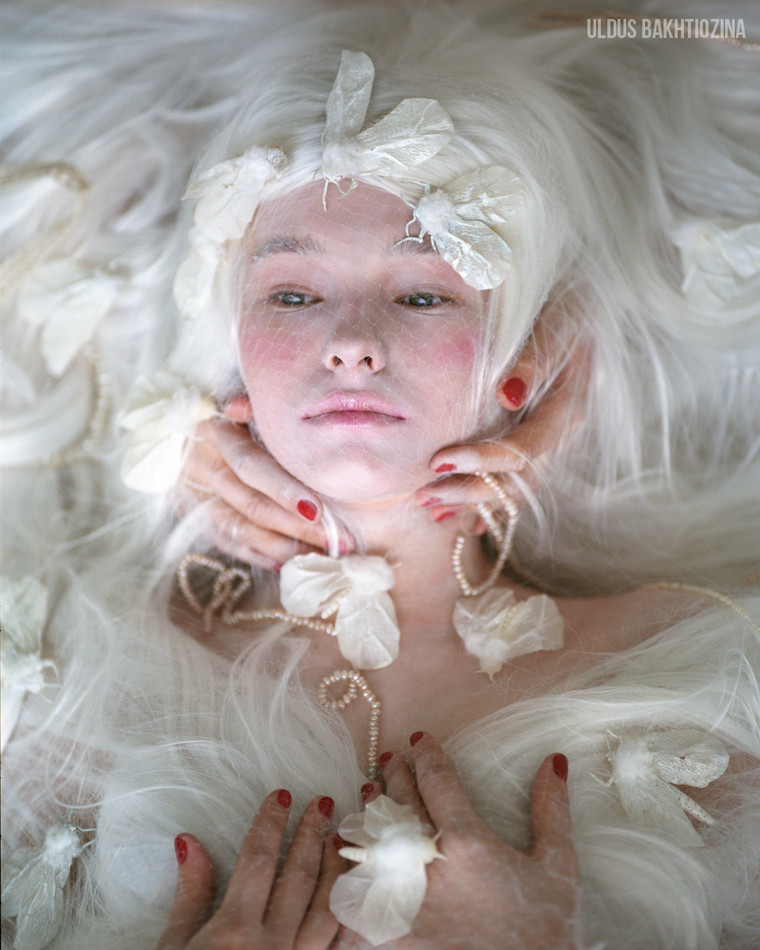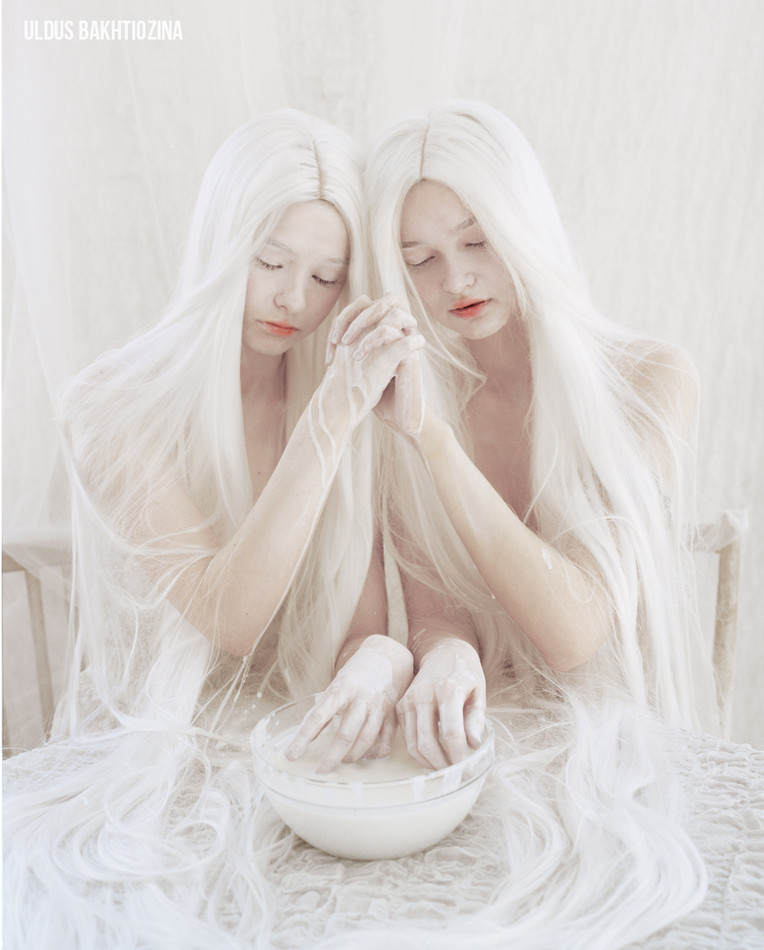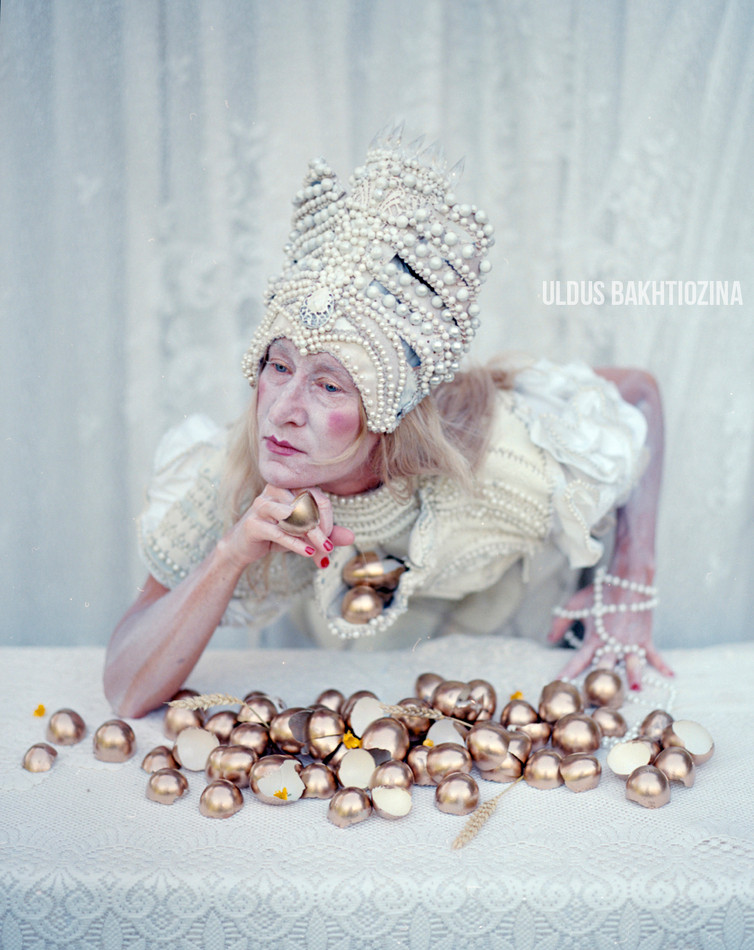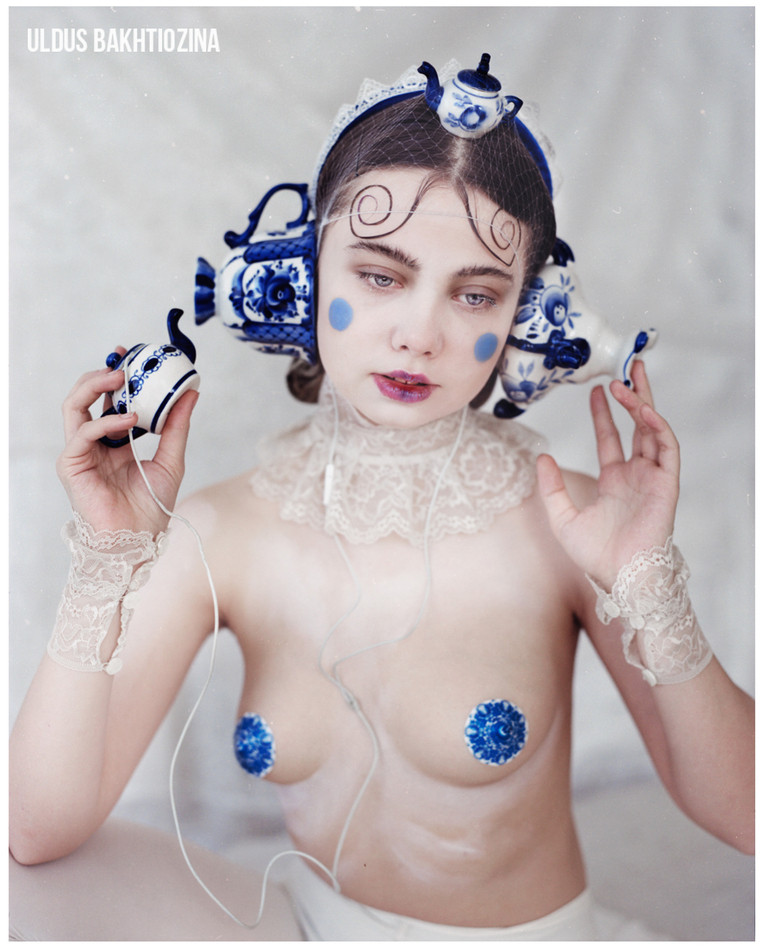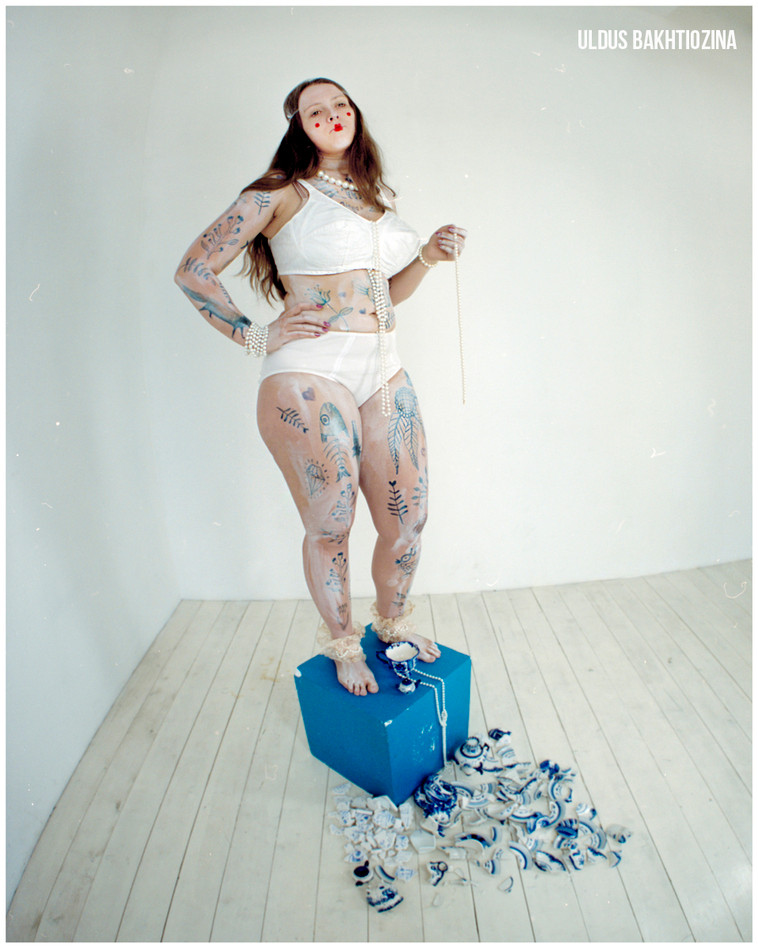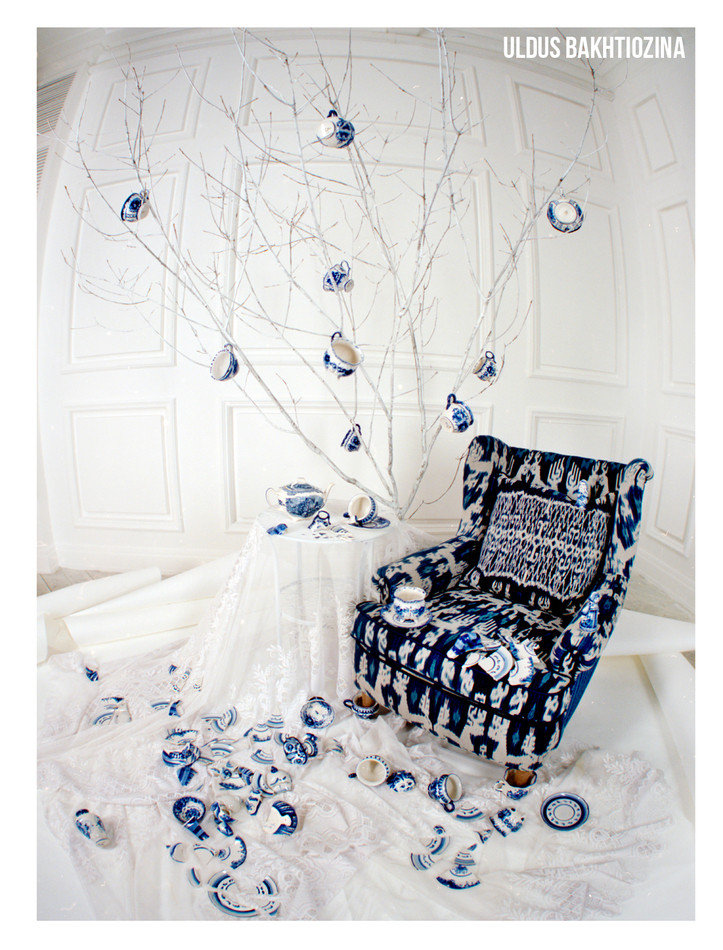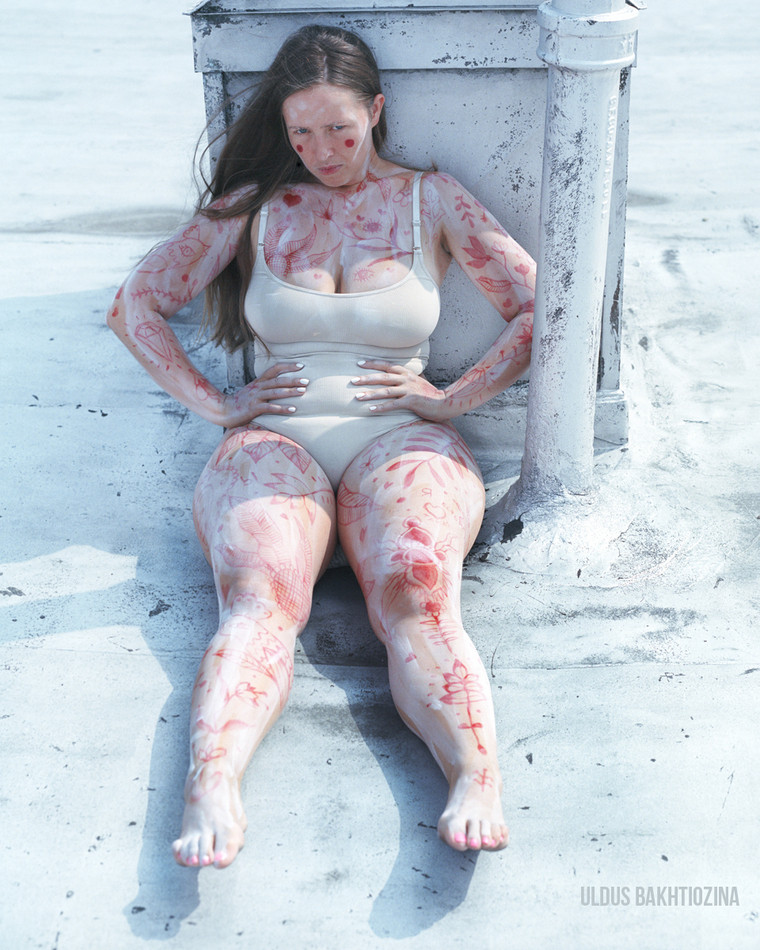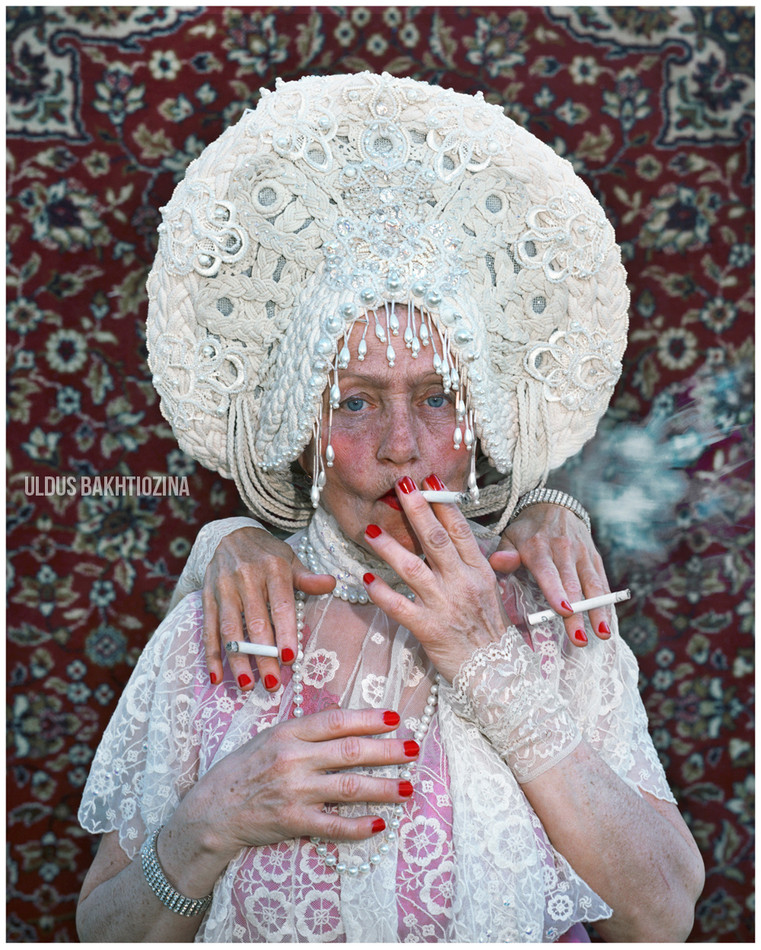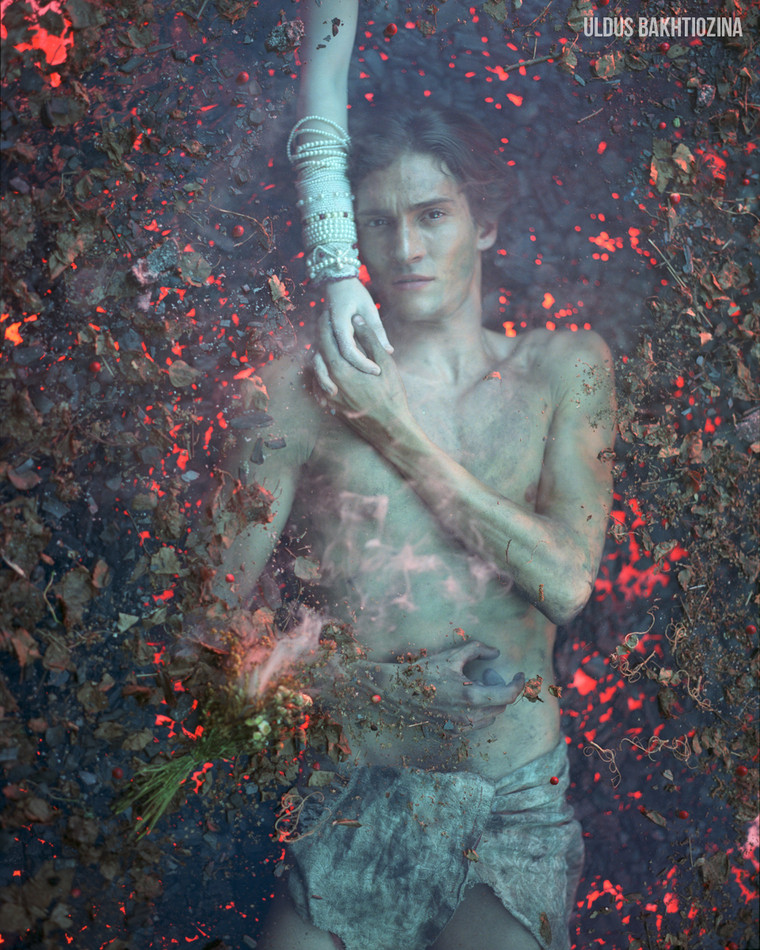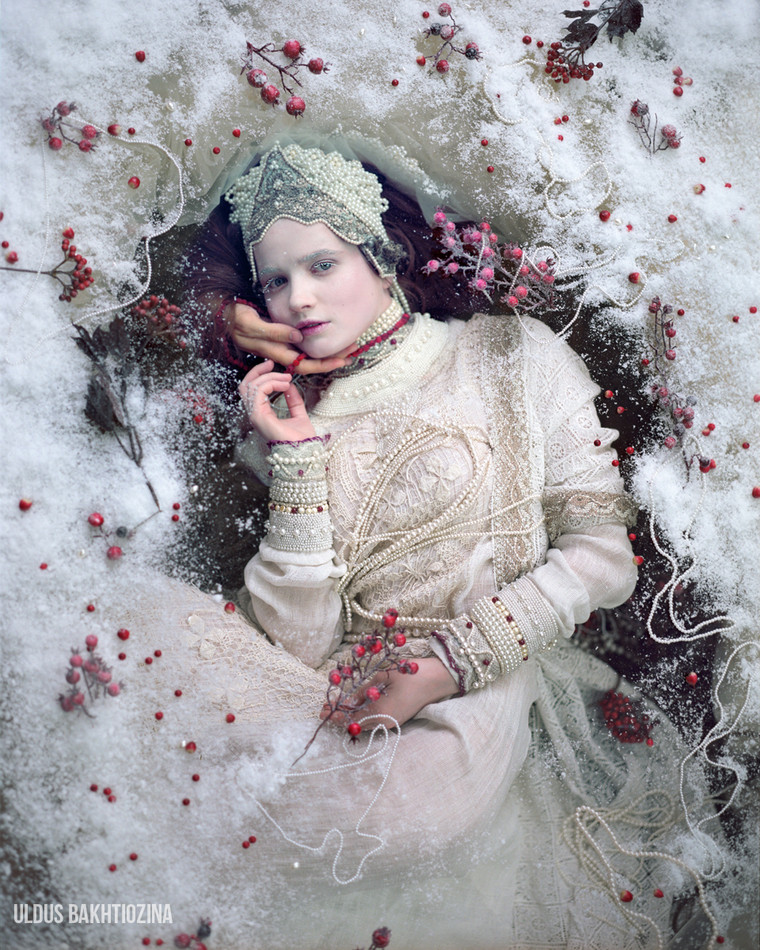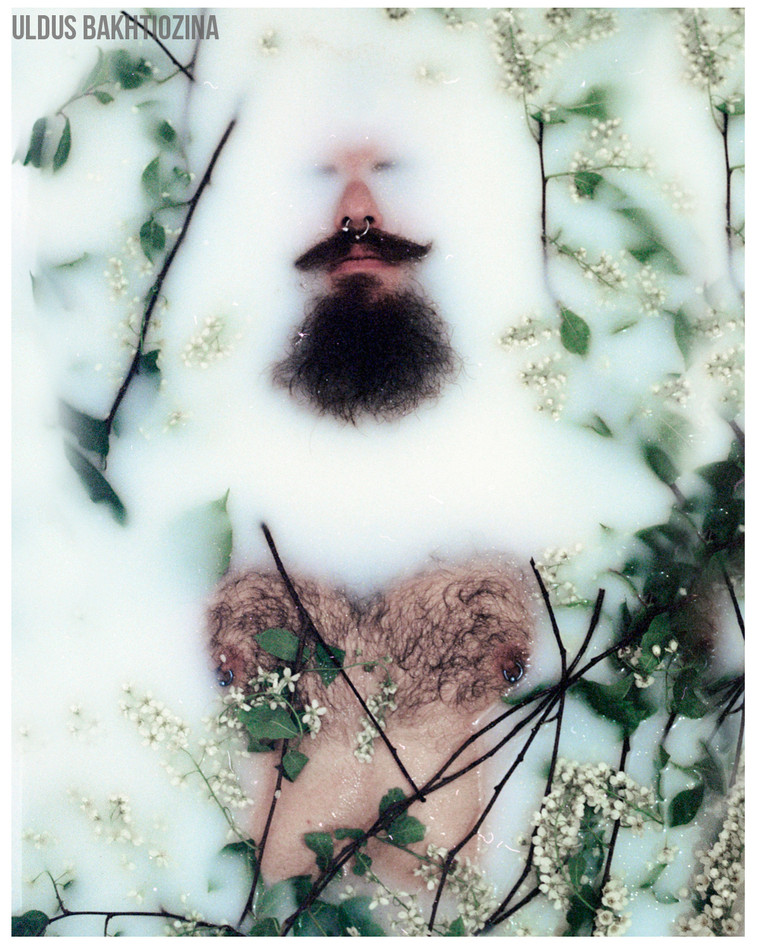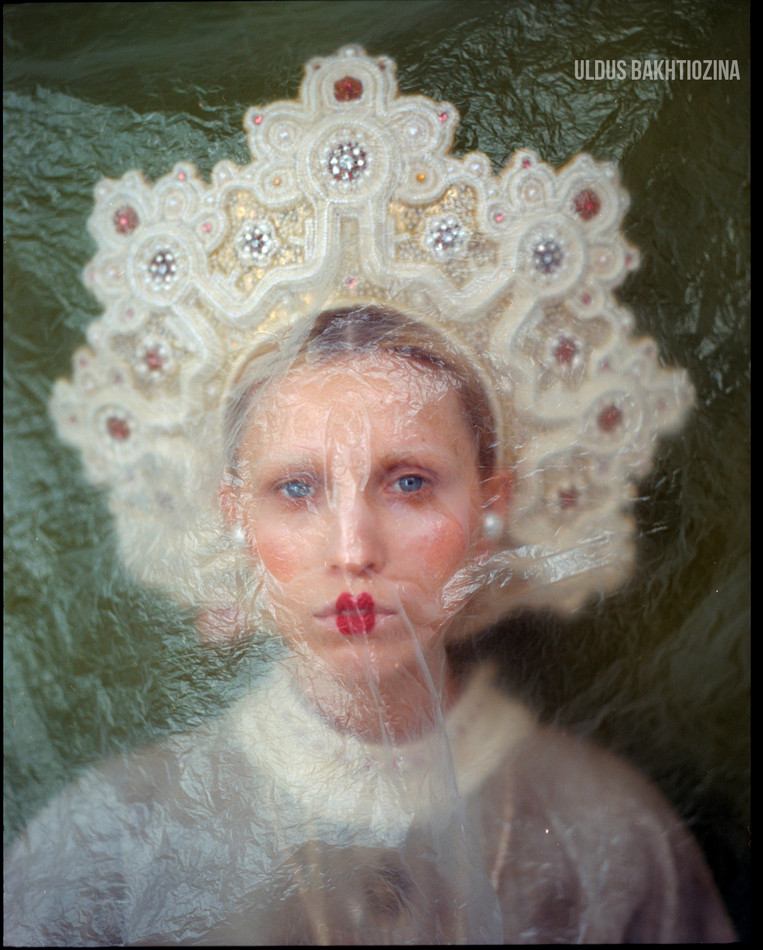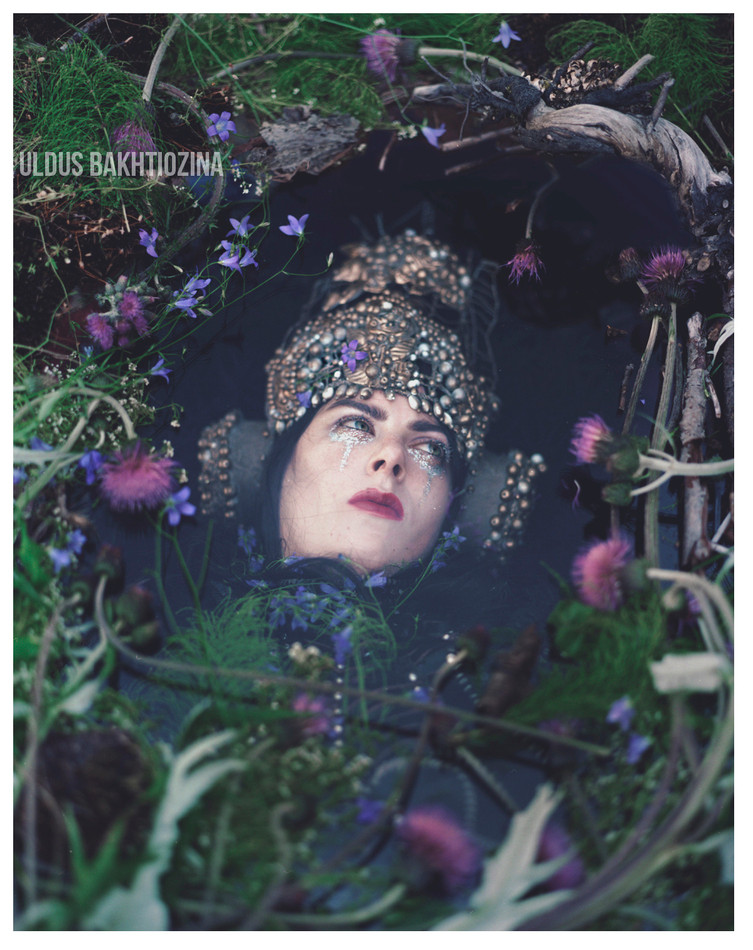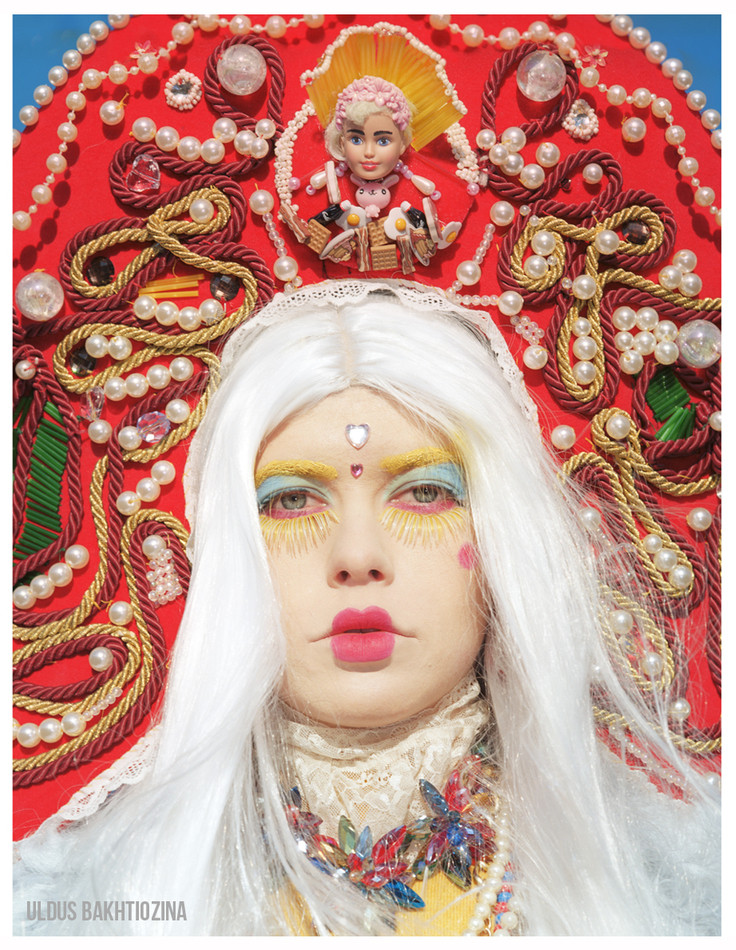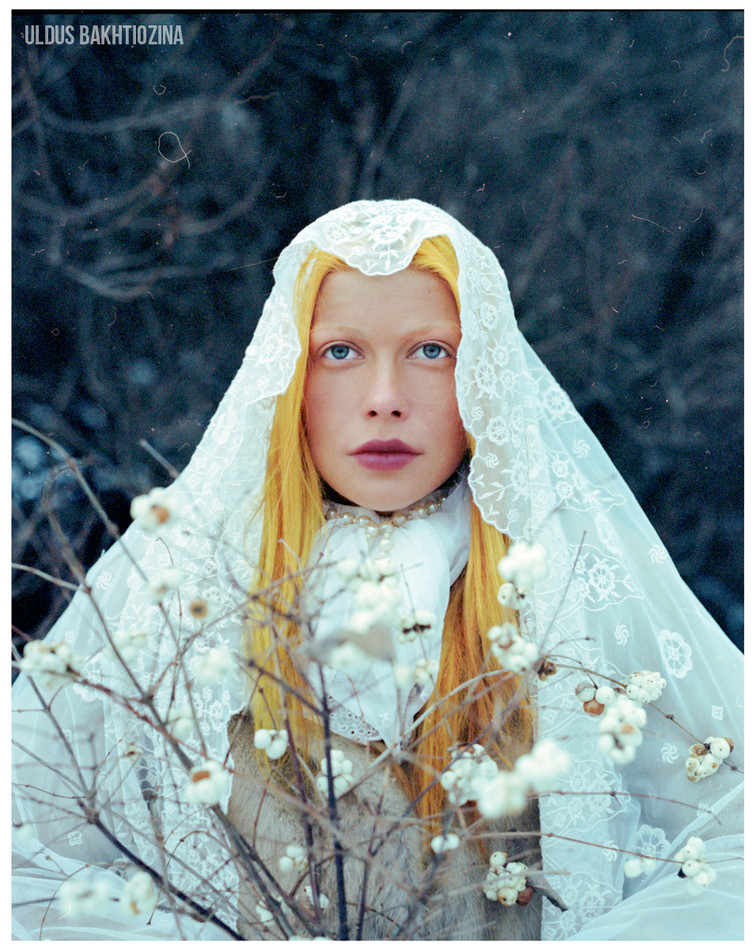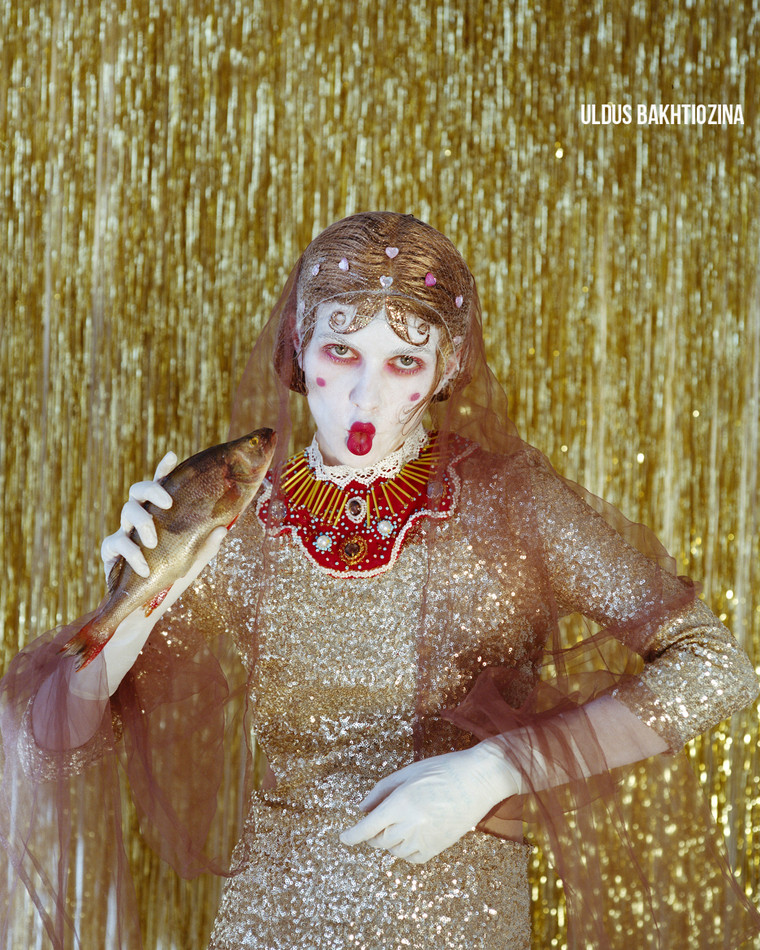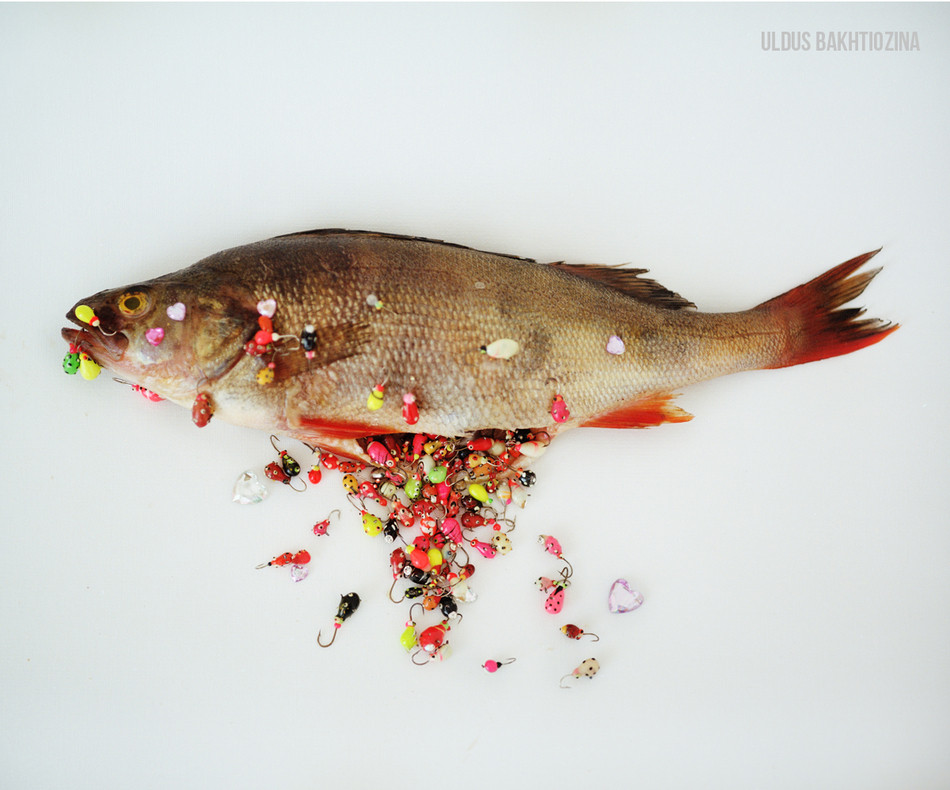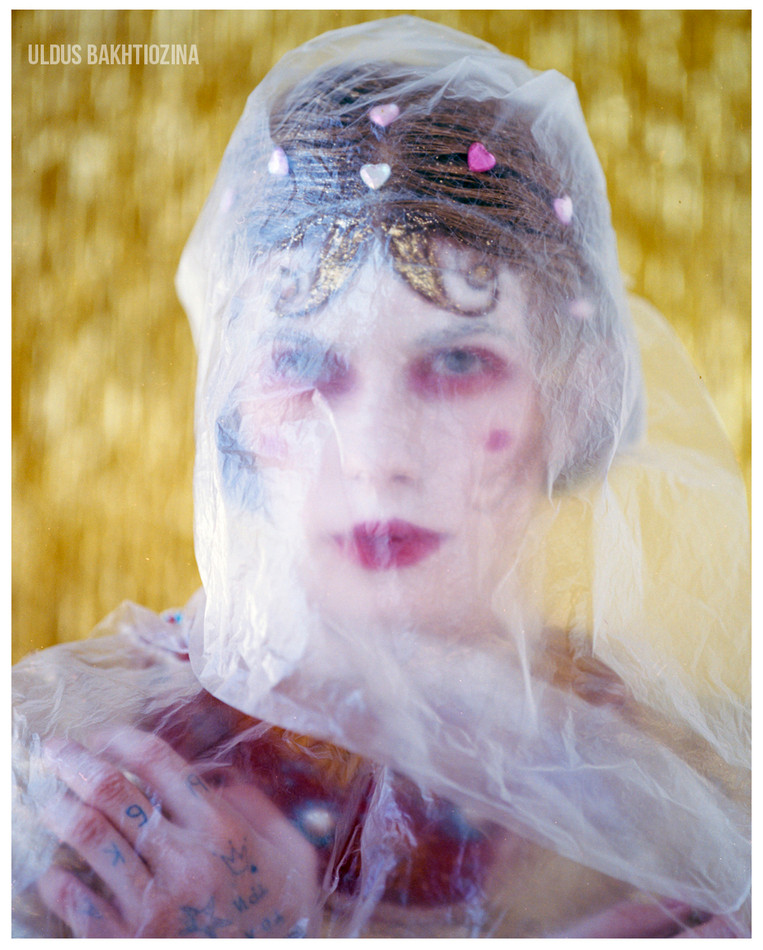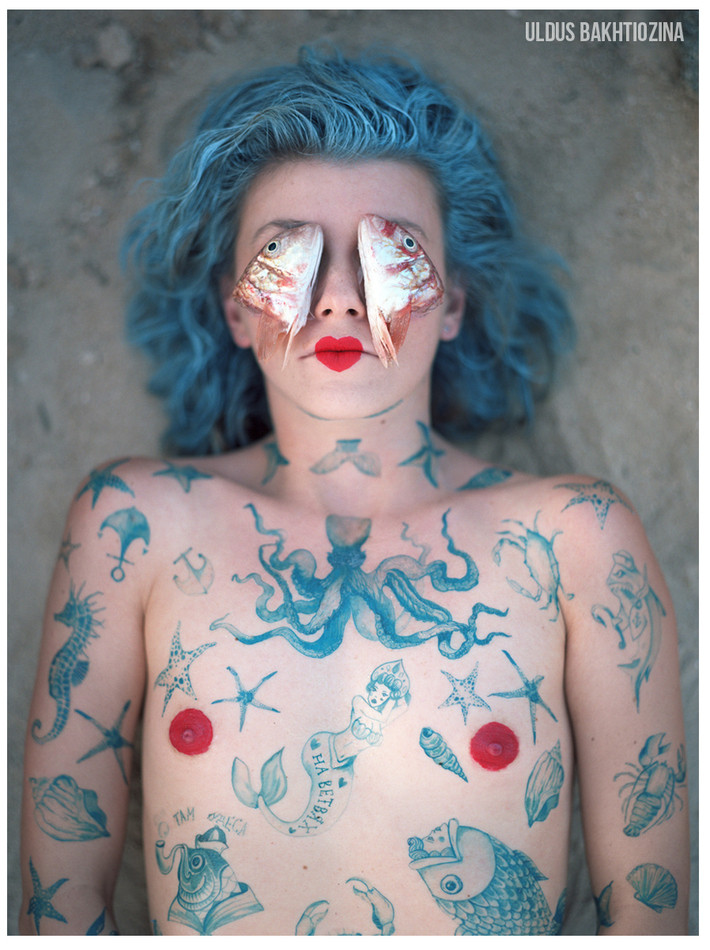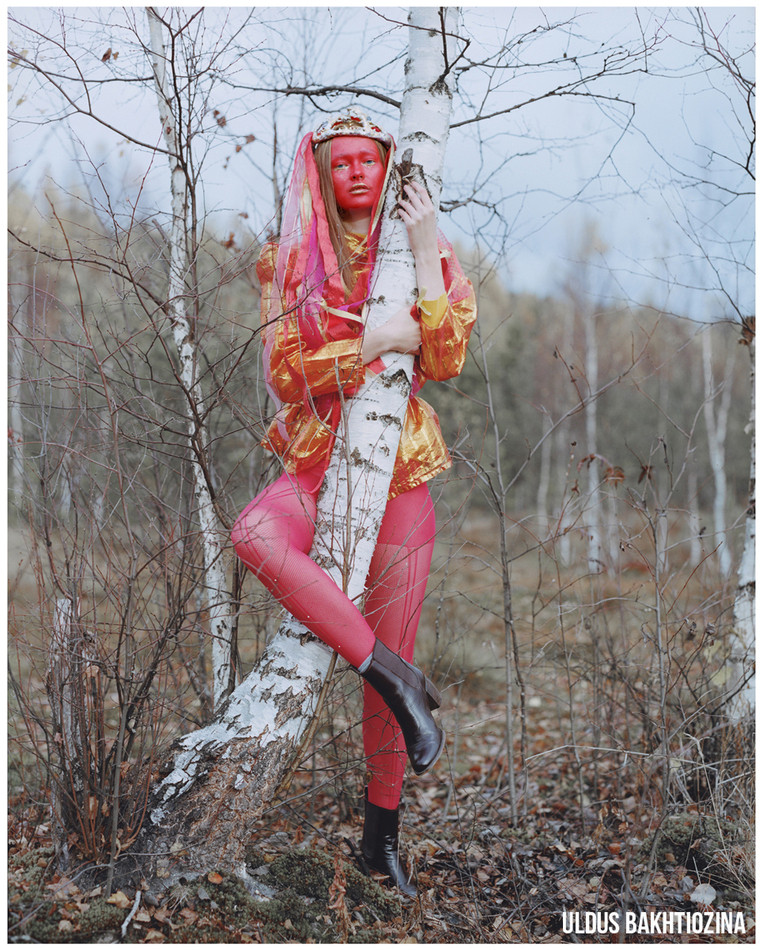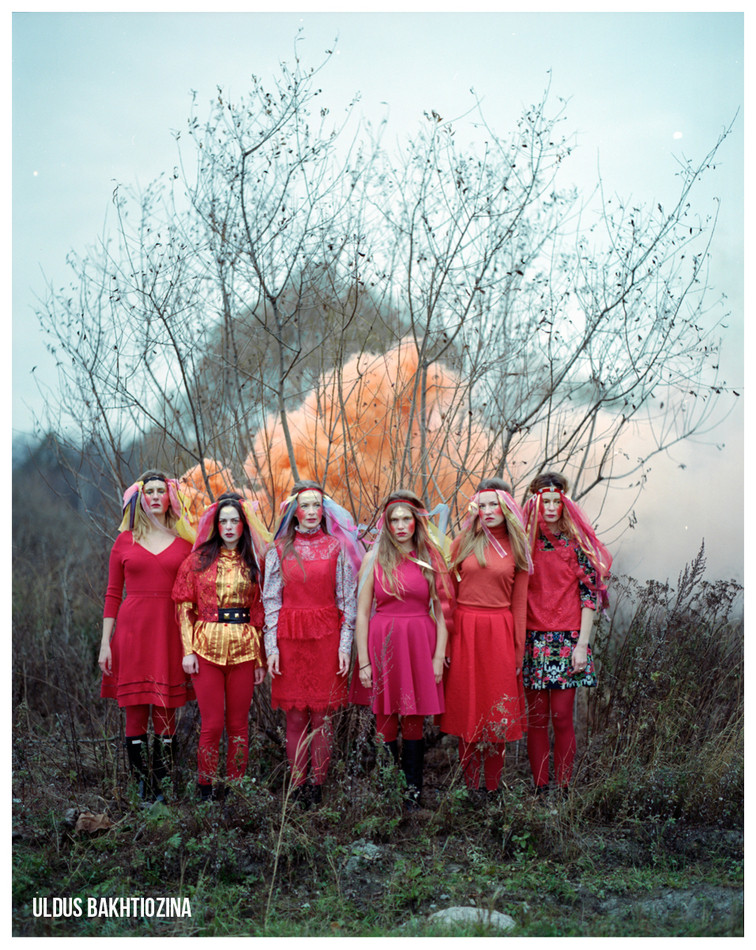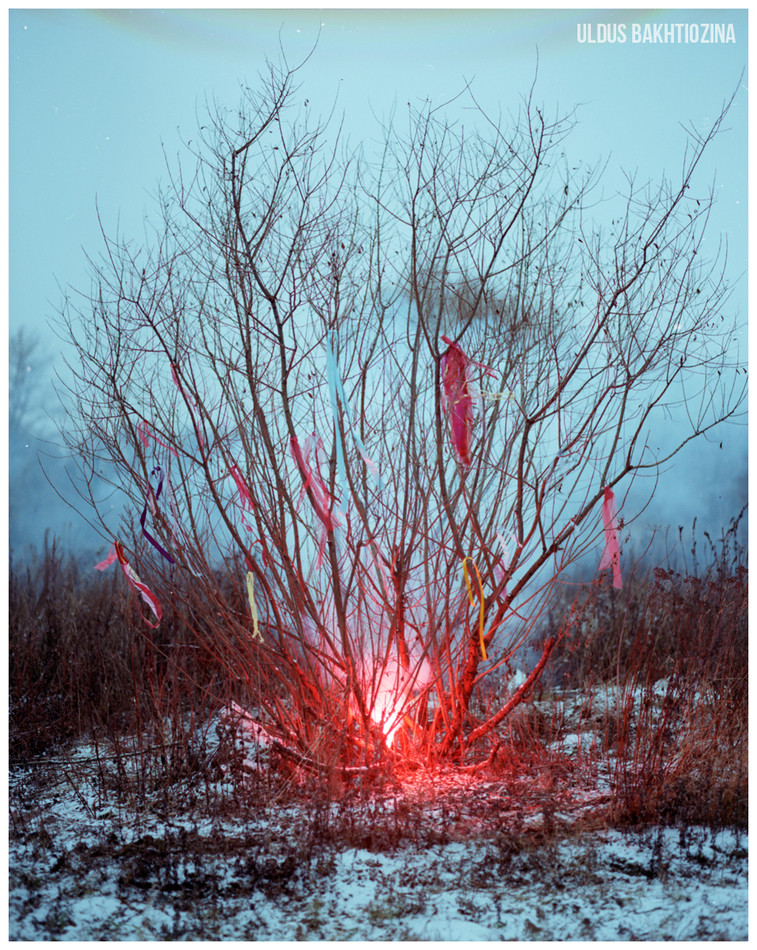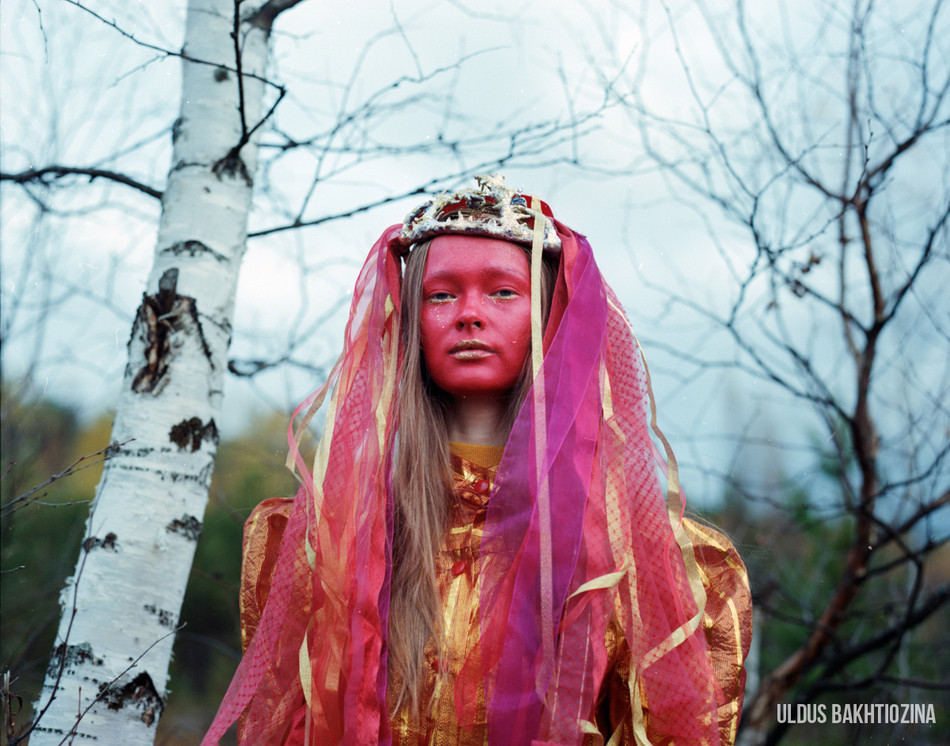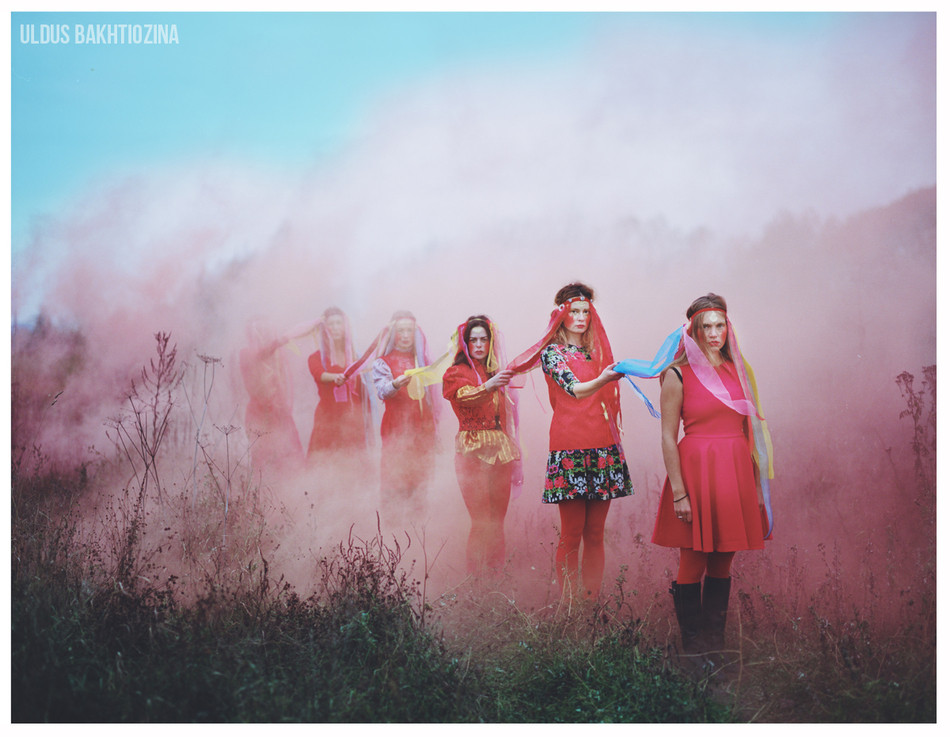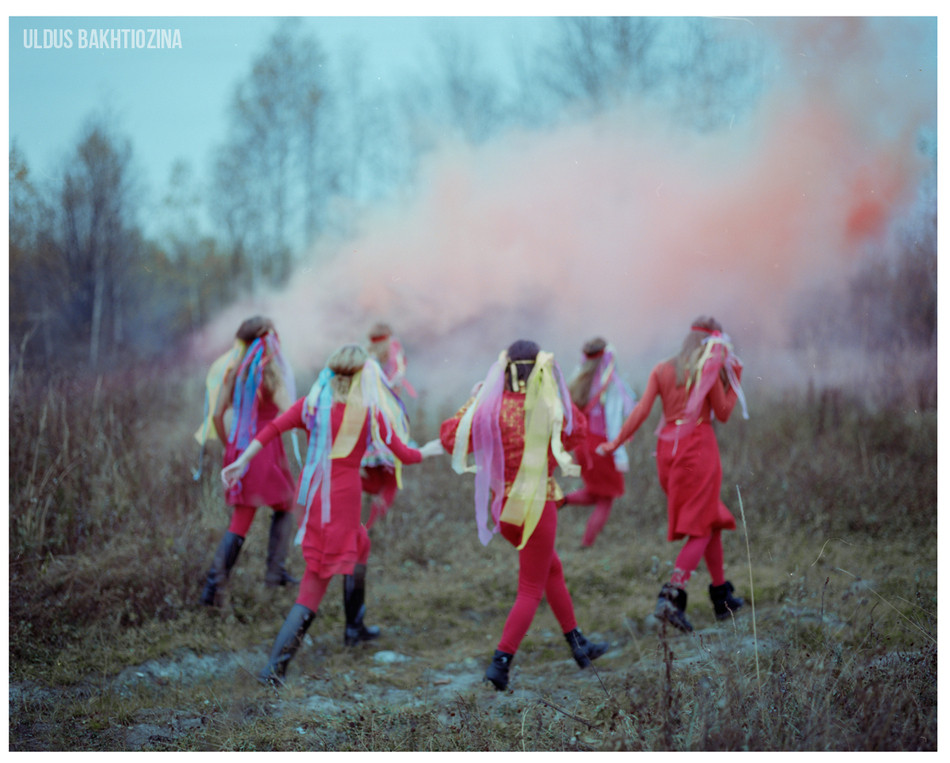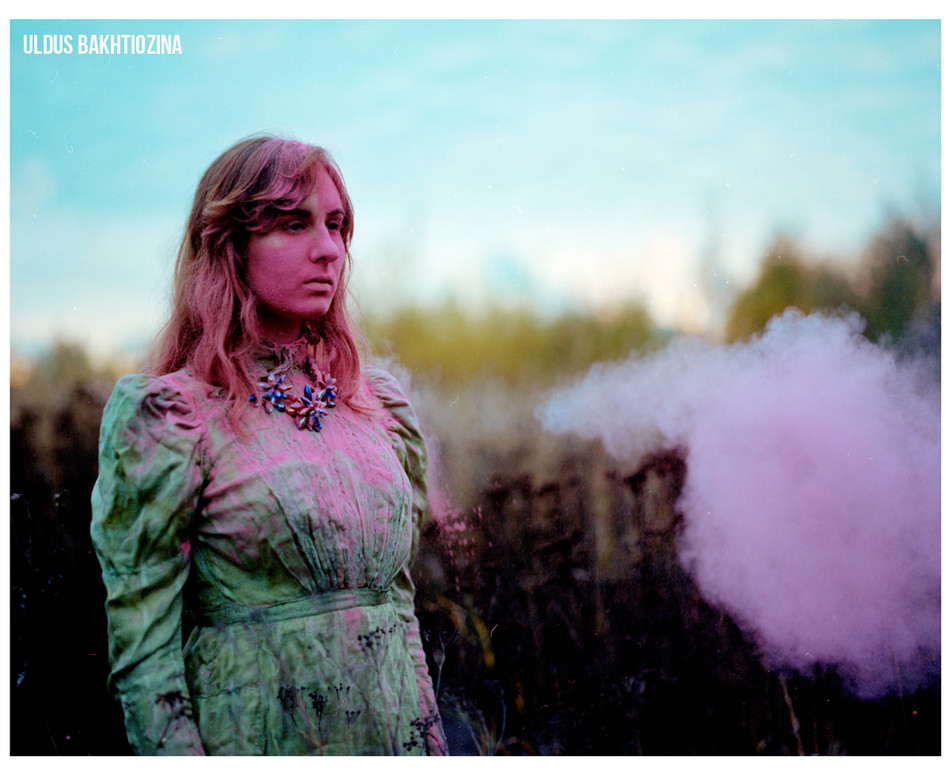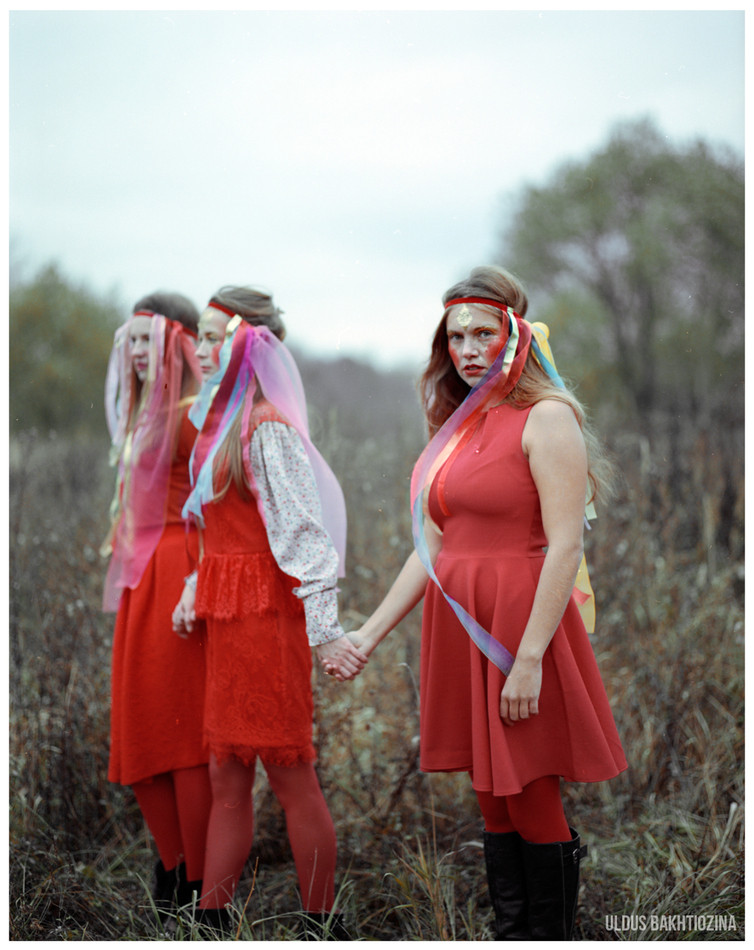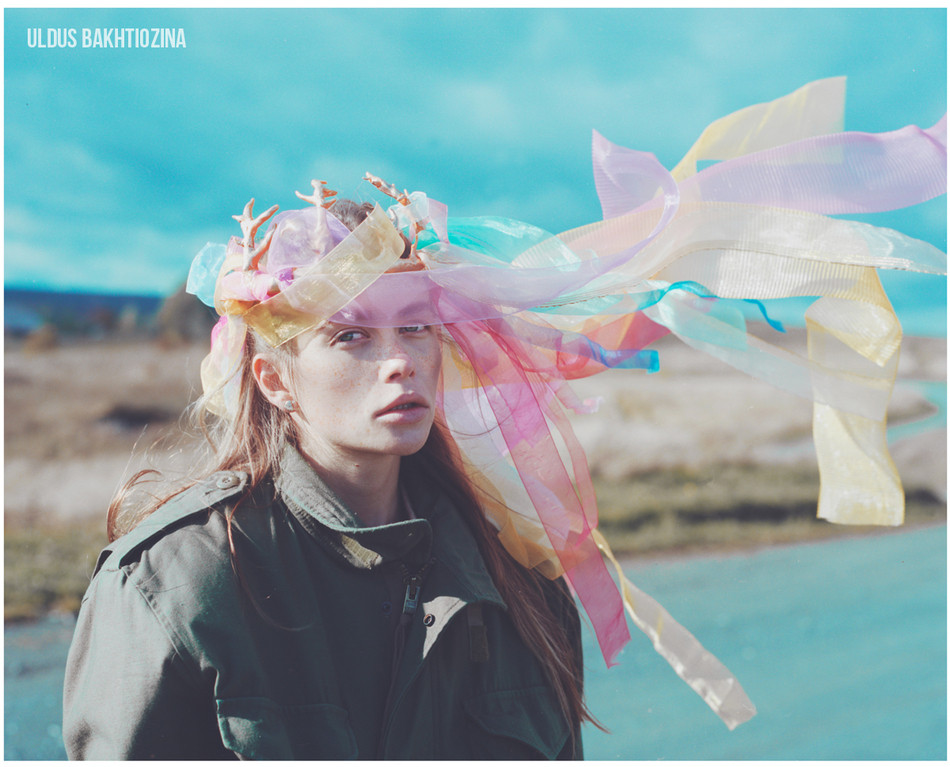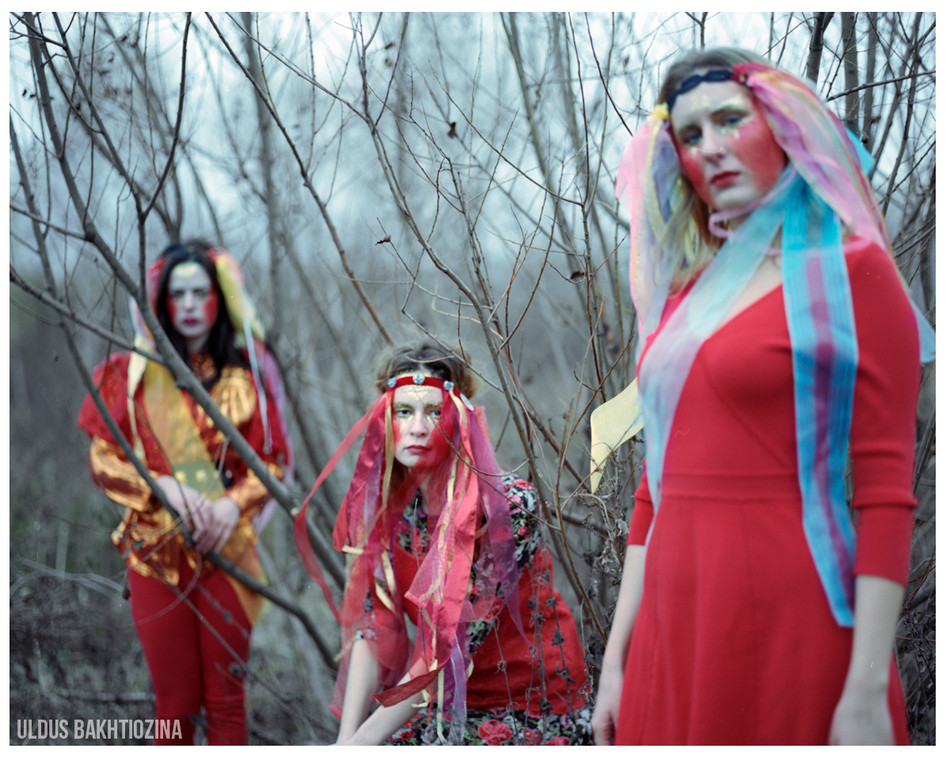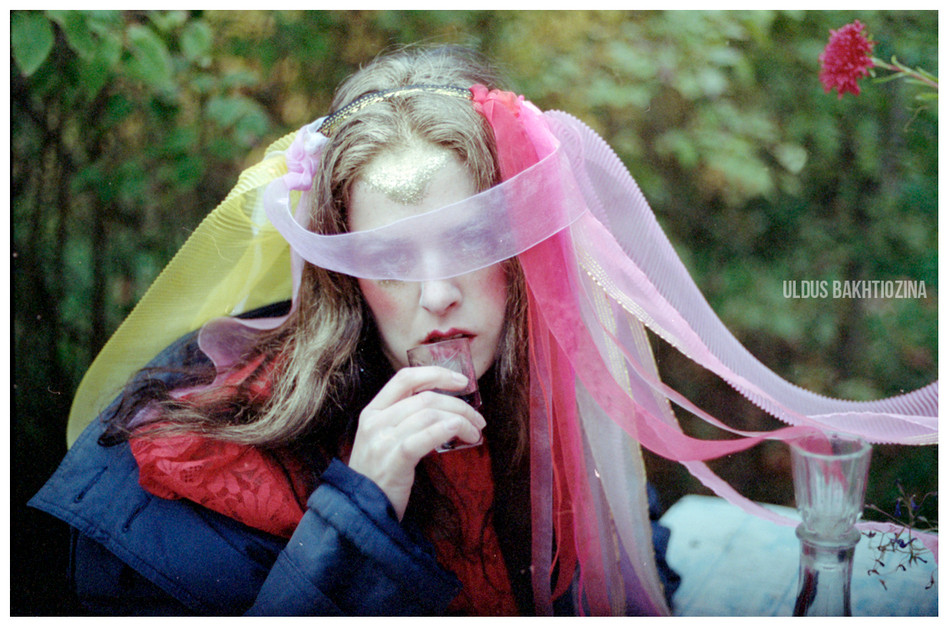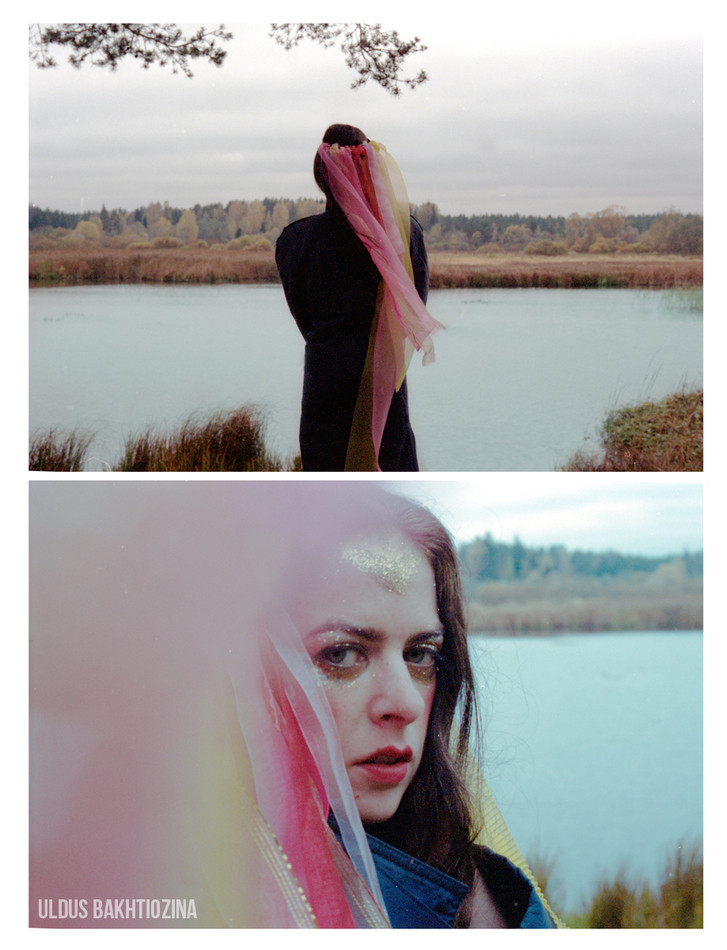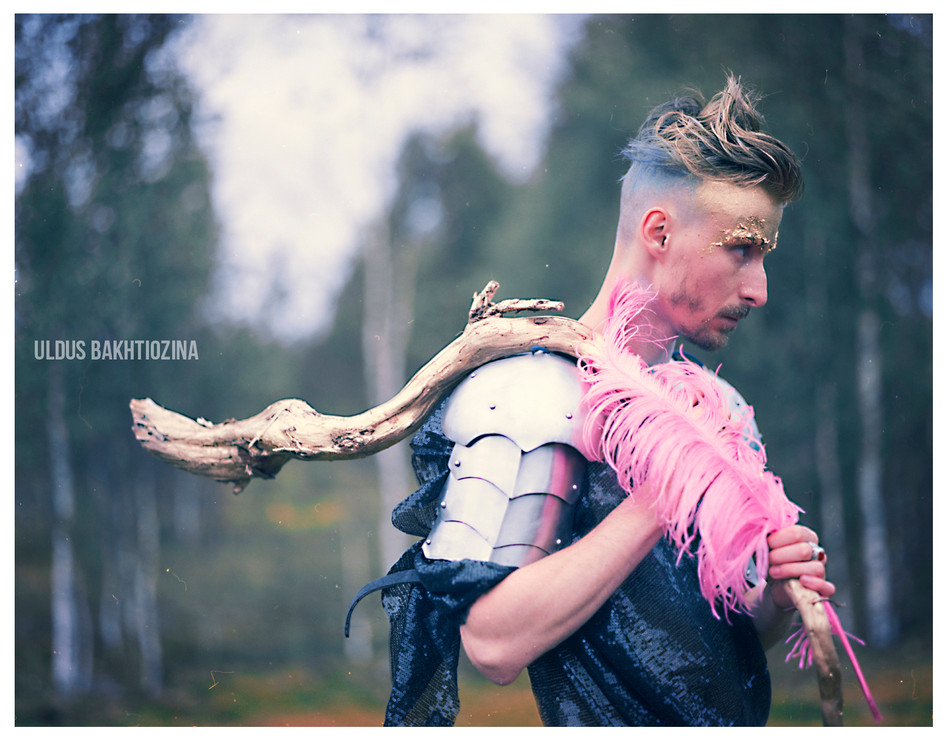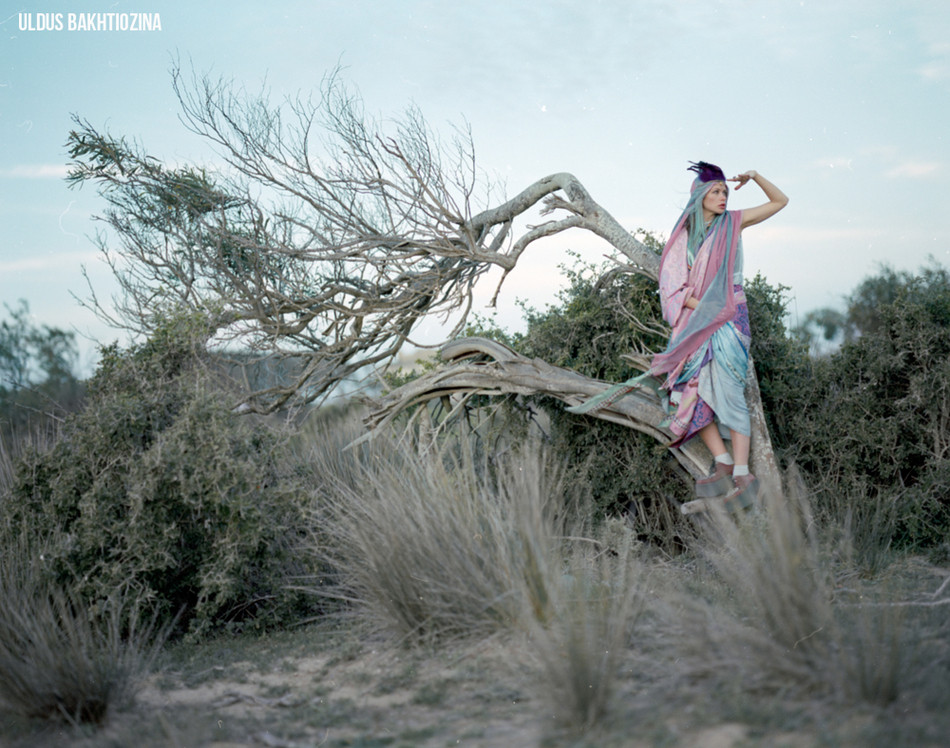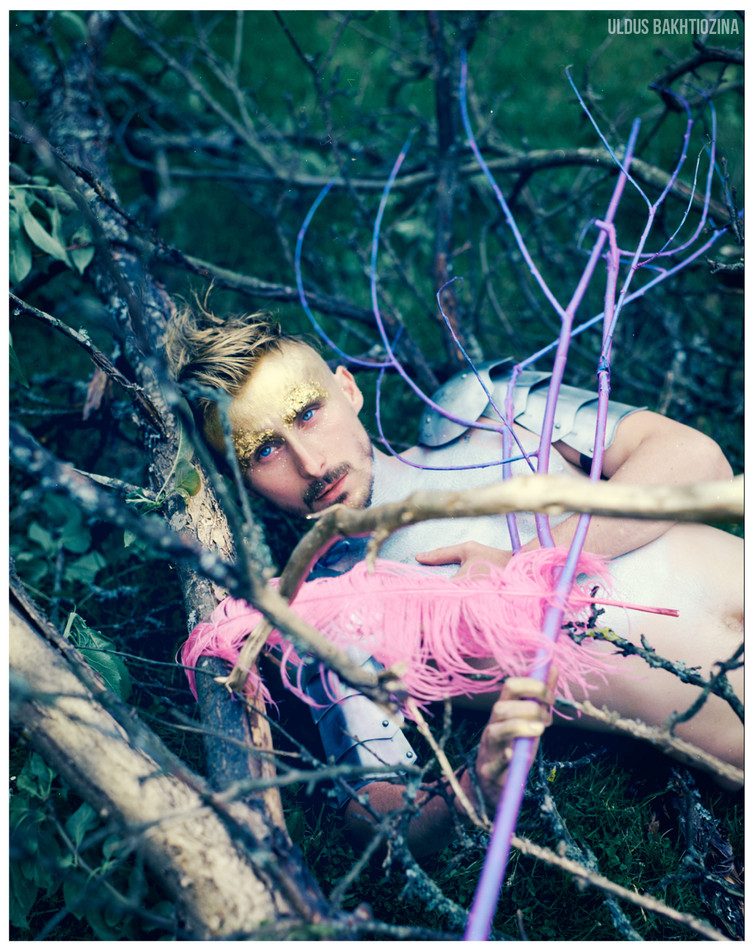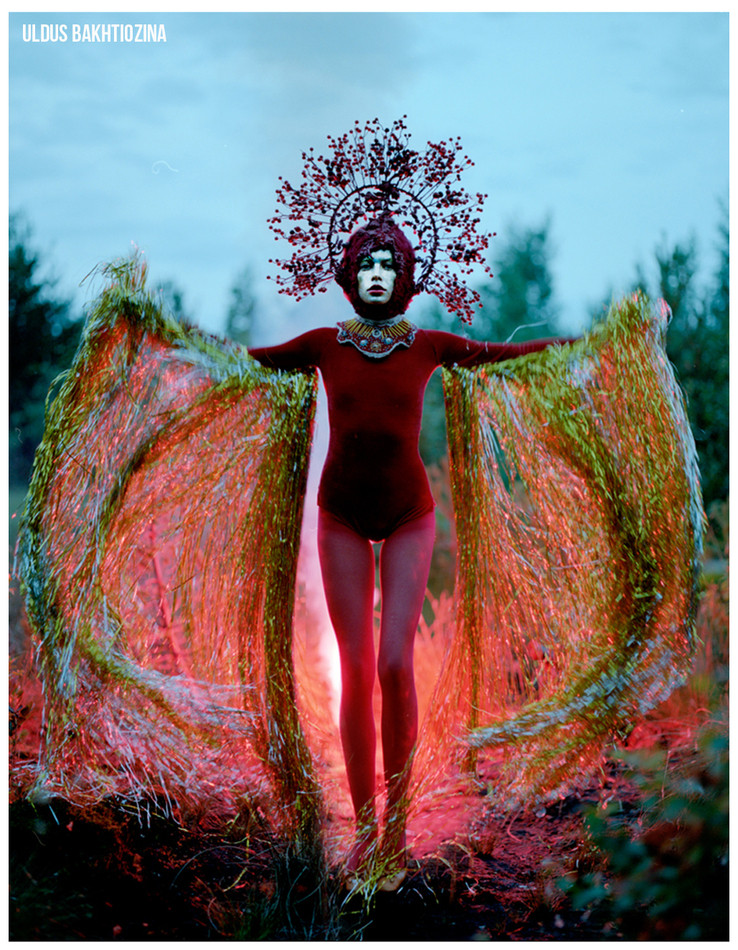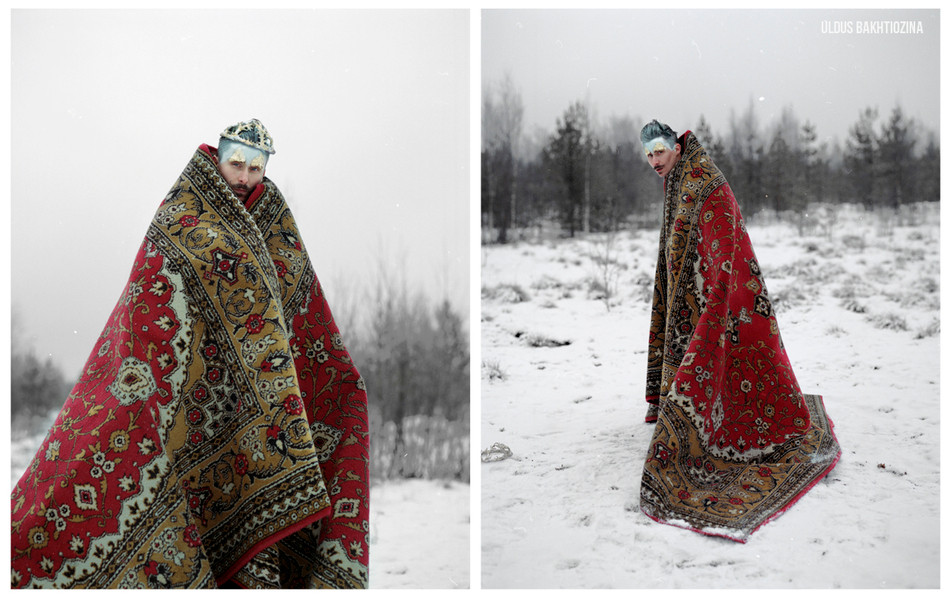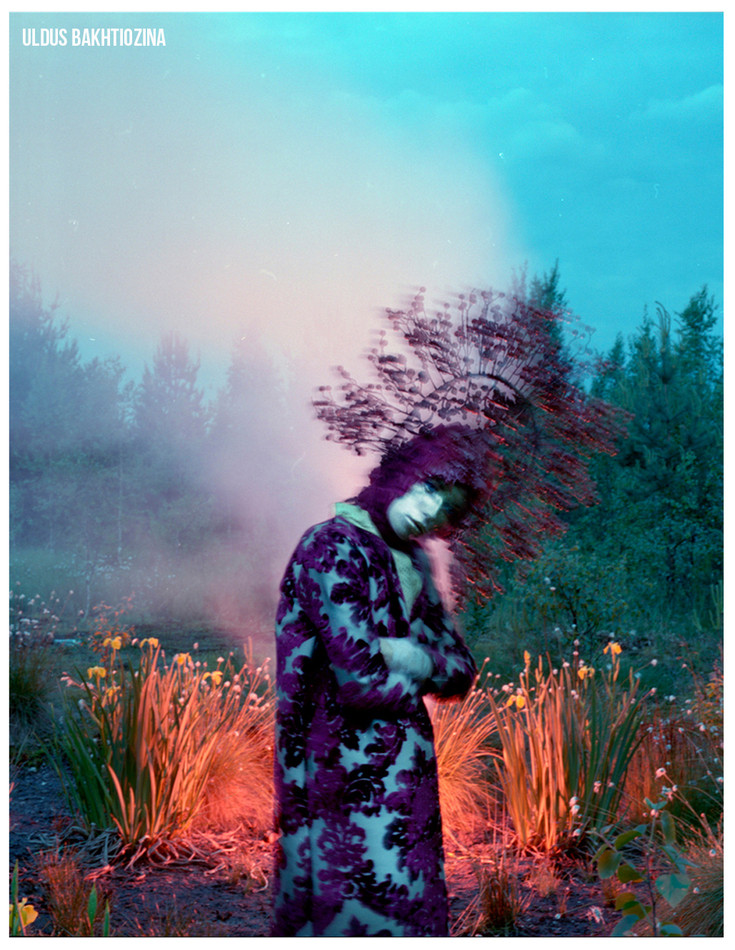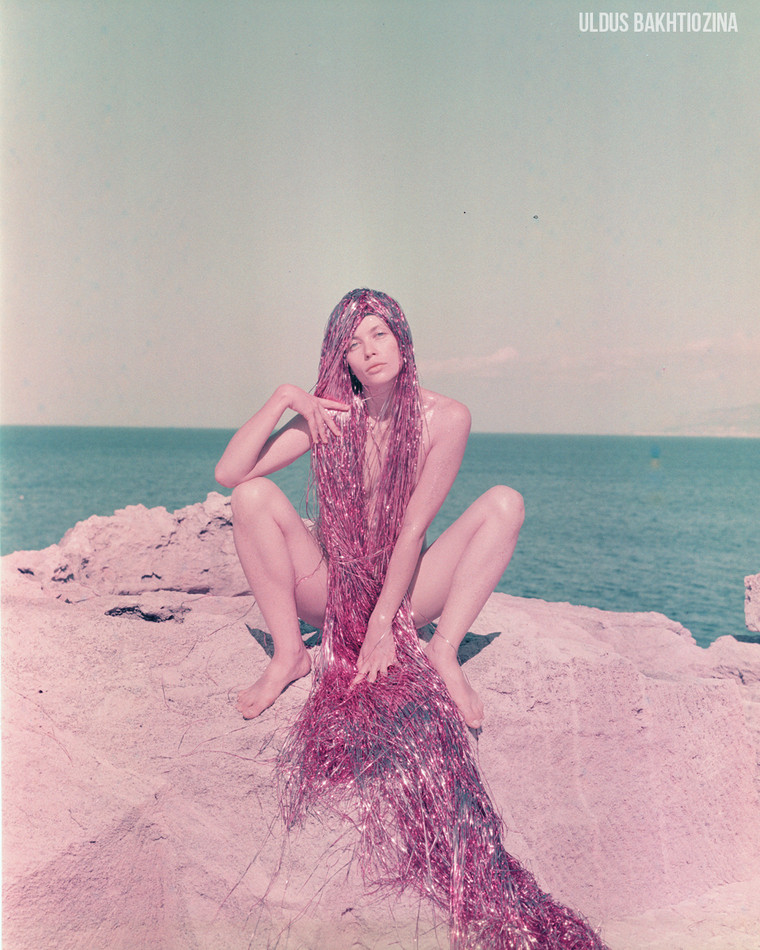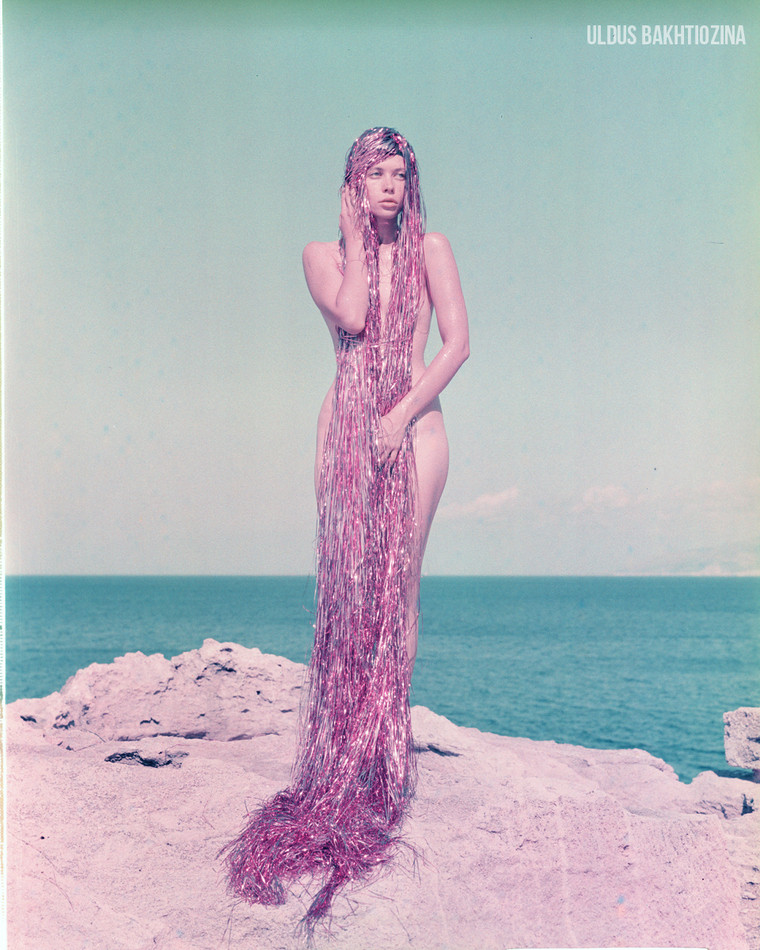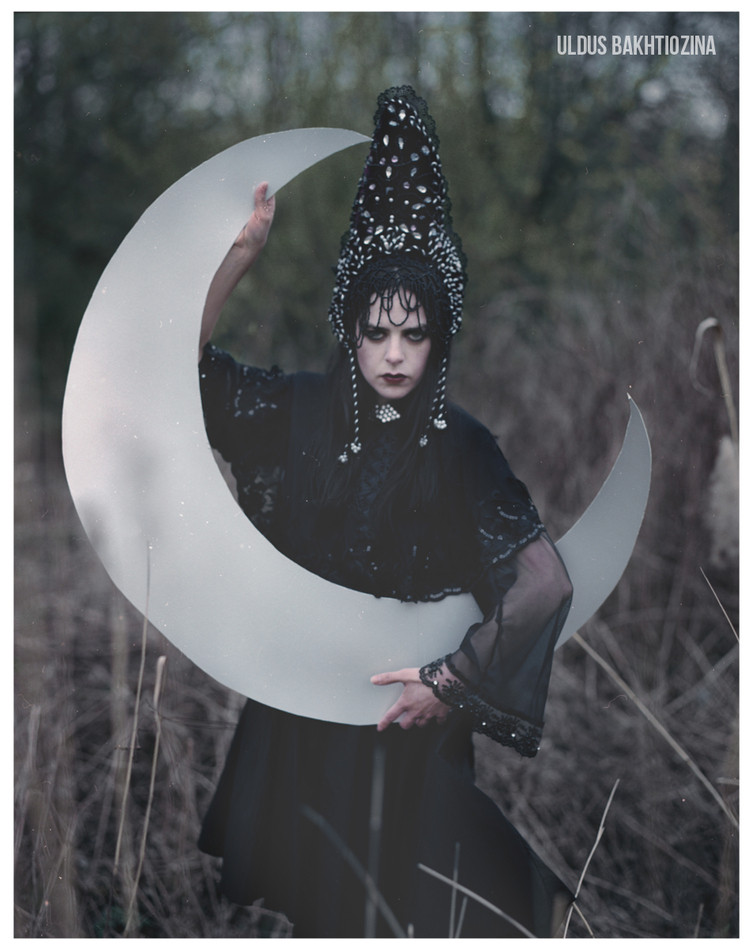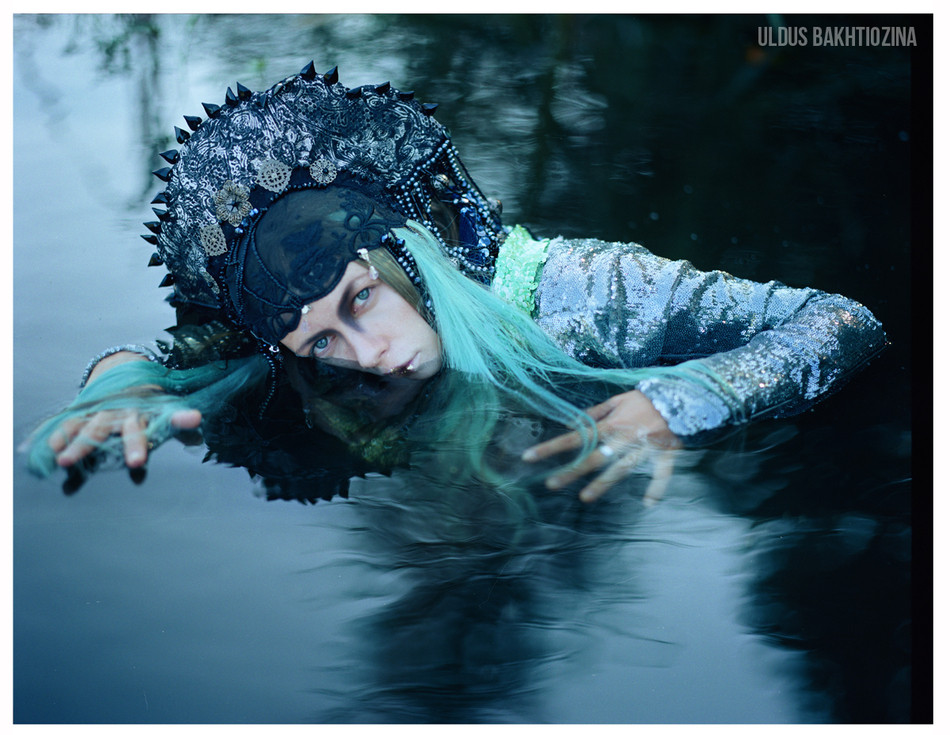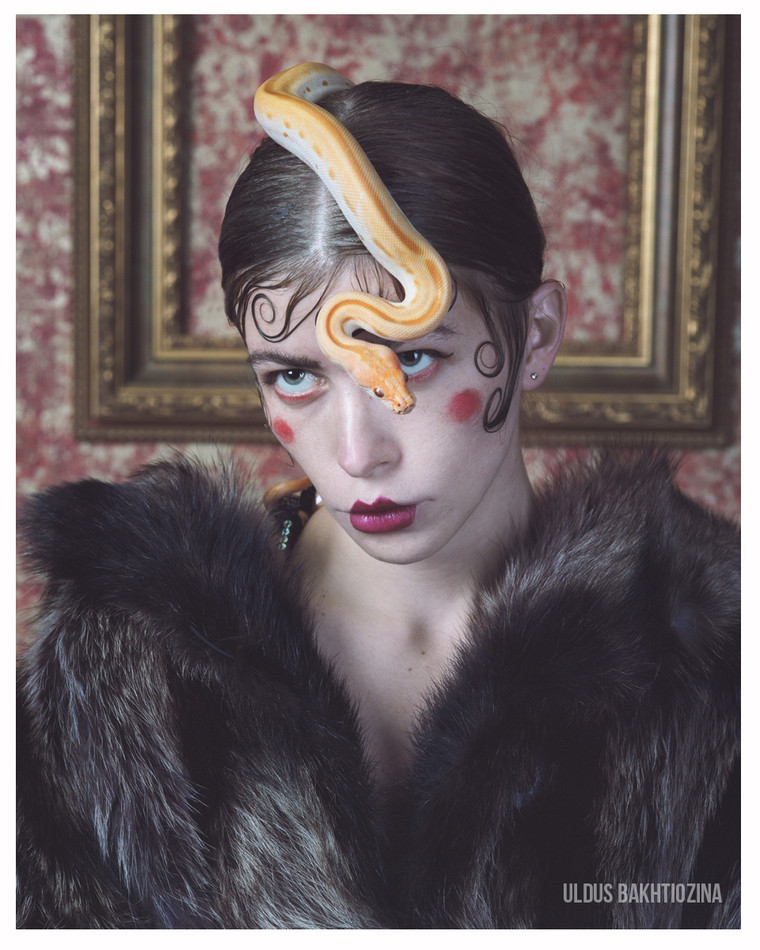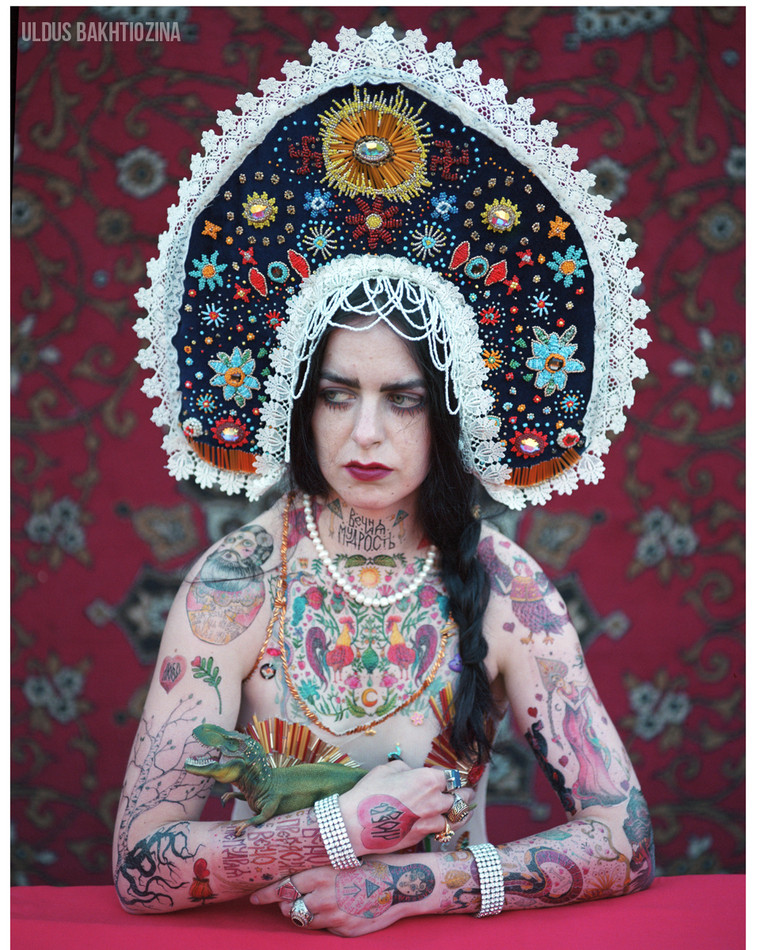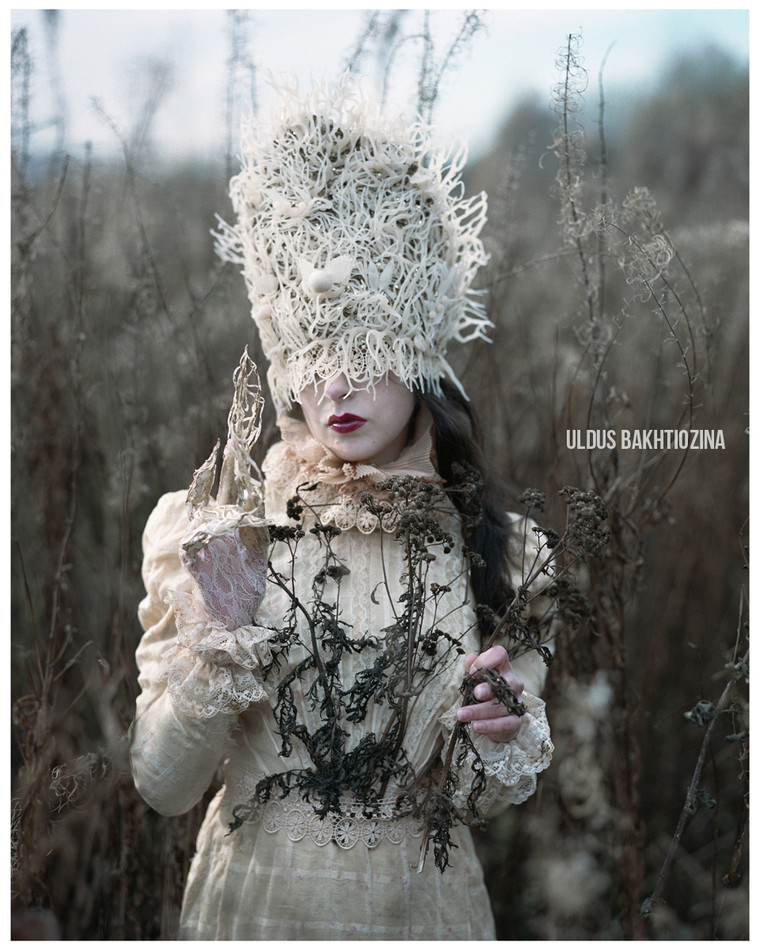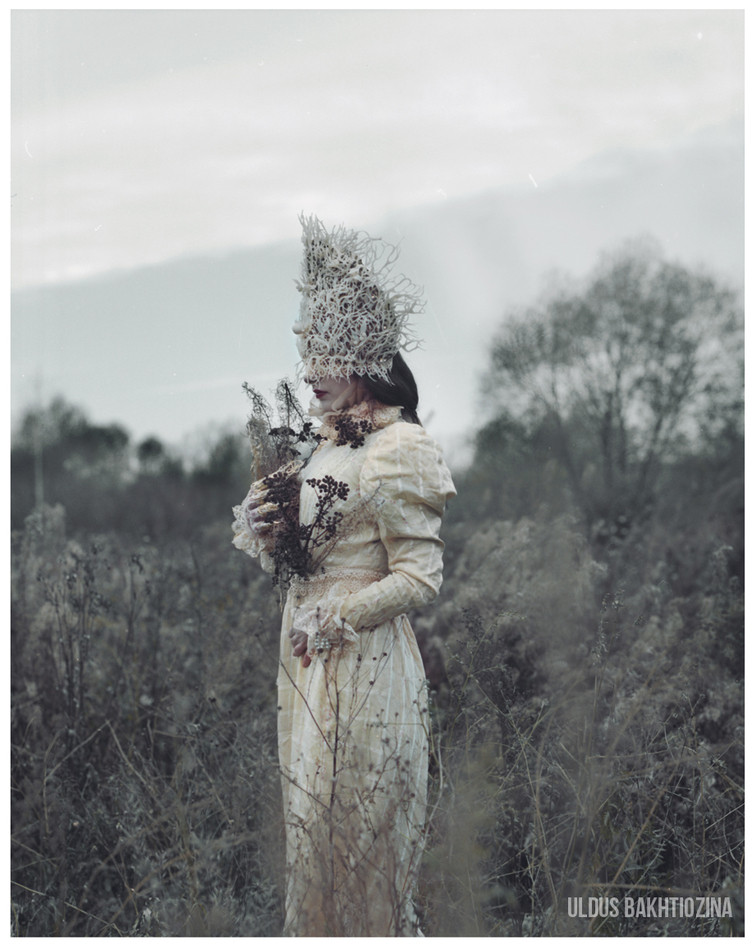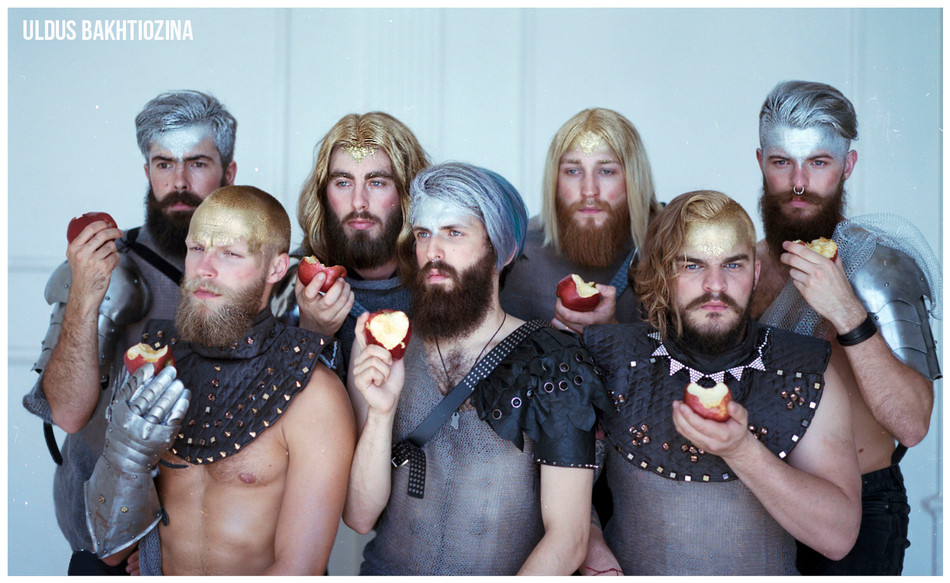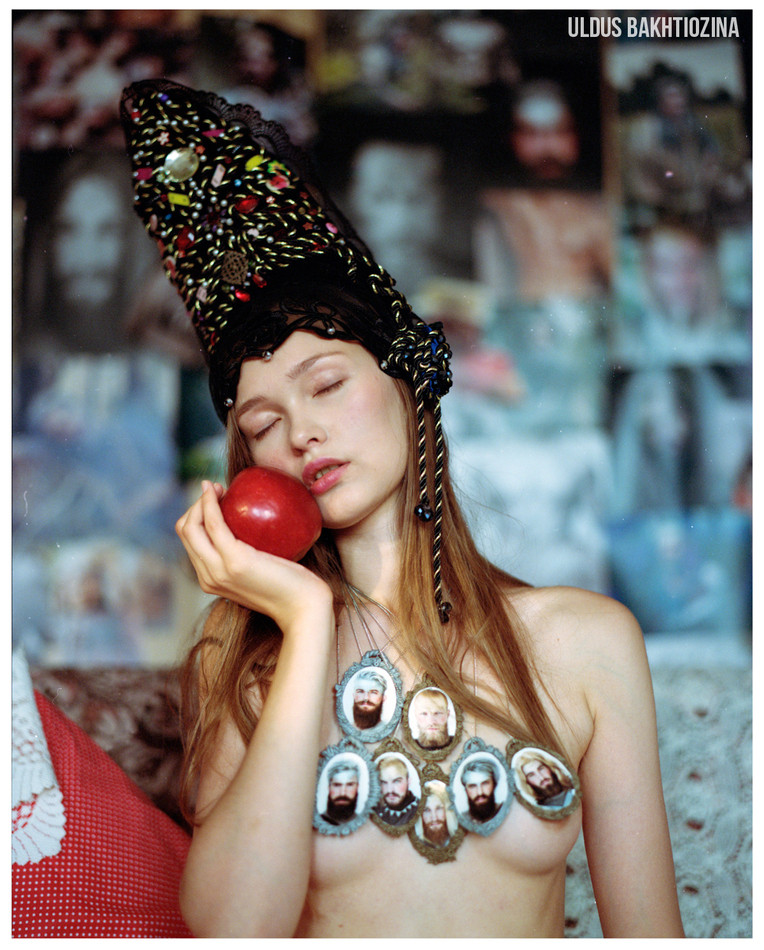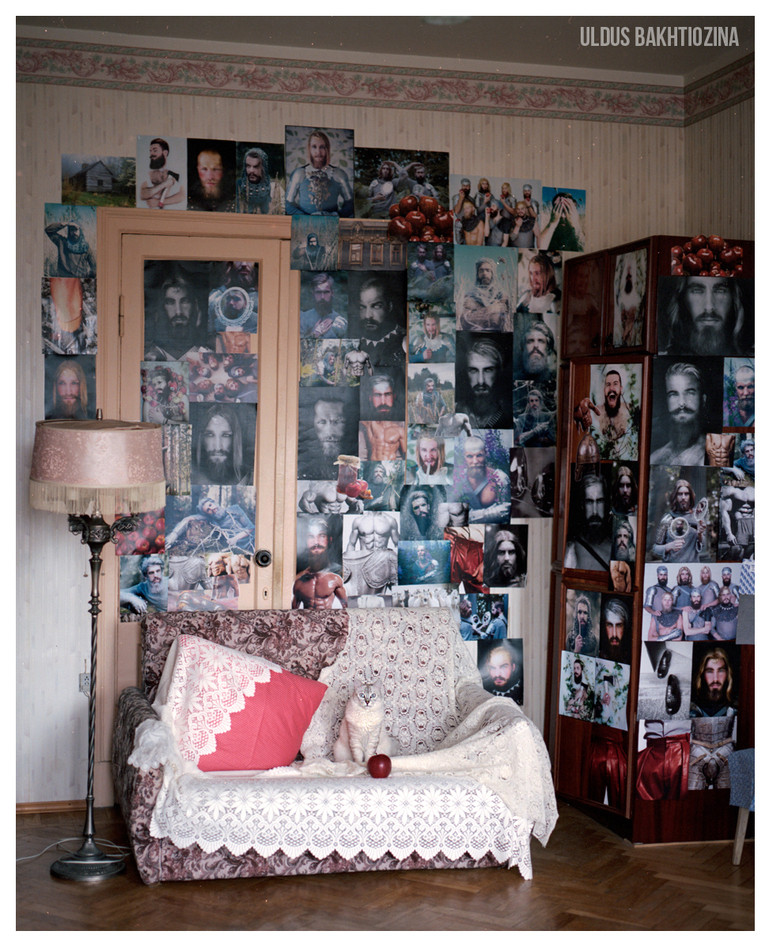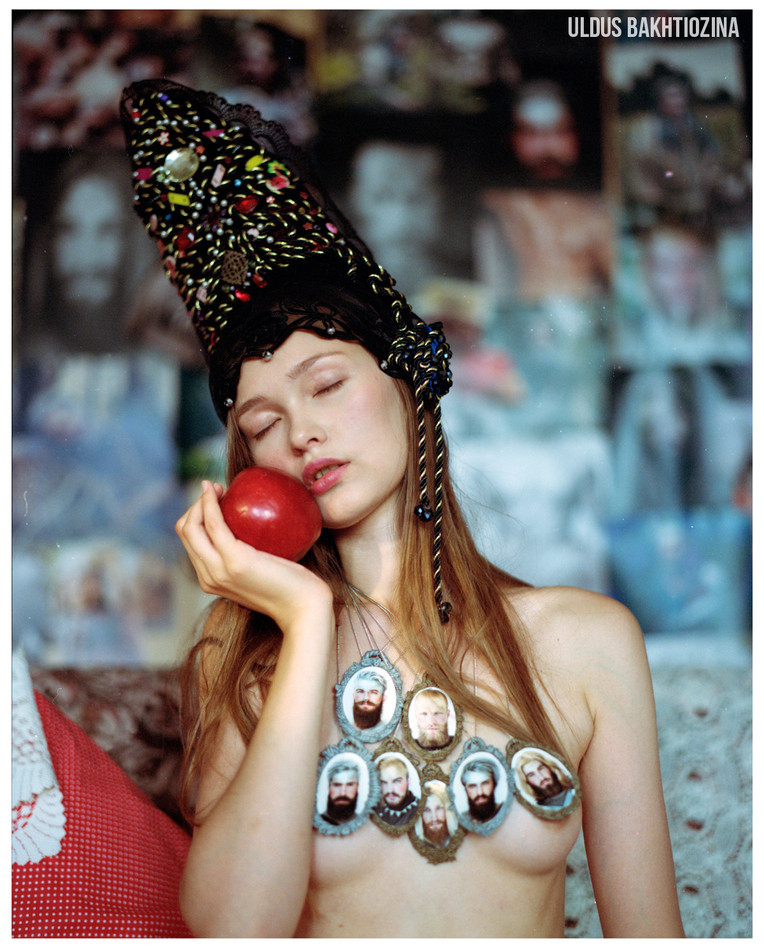RUSS LAND
YAWING BEAUTY
"Татарское Барокко" год создания 2016.
Работа возглавляет период, с которого художник Юлдус Бахтиозина назвала свой стиль, как "Татарское Барокко", подчеркивая и любовь к своим татарским корням и к любимому стилю в архитектуре и искусстве: Барокко. Сама работа создана накануне 100-летия революции 1917 года, которая повлекла за собой огромное количество разрушенных храмов, а также икон. Как художник, а также вышивальщица (Юлдус закончила школу Церковной вышивки в г. Санкт-Петербург), художник очень неравнодушно относится к разрушенным произведениям искусства и религии. Так эта работа символизирует икону без ризы (оклада), так часто встречающиеся на постсоветском пространстве, когда большевики уничтожали иконы, оставляя лишь ценные с материальной точки зрения оклады. Таких риз без икон осталось великое множество в музеях и некоторых храмах России. Кокошник также выполнен в старинных техниках церковной вышивки.
Дым изо рта персонажа как отсылка ко множеству сожженных или превращенных в крематории храмов на территории СССР. Работа метафорично изображает целую эпоху.
Ри́за, или окла́д — накладное украшение на иконах, покрывающее всю иконную доску поверх красочного слоя, кроме нескольких значимых элементов (обычно лика и рук — так называемого лично́го письма), для которых сделаны прорези; значимый вид русского декоративно-прикладного искусства.
Бывали металлические: золотые и серебряные, также из латуни, меди и даже белой жести; шитые: бисером или жемчугом («жемчужная обнизь» и «бисерное шитьё»), украшенные эмалью, подчас с драгоценными камнями, цветными стёклами и накладными деталями. С обратной стороны порой обивались красным или малиновым бархатом.
WITHIN DARK FLOWER
GOSSIP BEAUTY
WHITE SWAN
YAWING BEAUTY #2
PRODUCTIVE HOUSE KEEPER
FASHION IN RUSS LAND
Analogue from July 2016
Kokoshniks Yuhan Nikadimus
Dresses from left to right: Off-Vintage, Polina Tammi
Gloves by Uldus
Idea, art directing, style, photo by Uldus
MASHA AND THE BEAR
Analogue from March 2015
Belt by Alina Muha
“Masha and the Bear” is a fairy tale about a little girl who loses her way in the forest and stumbles across an izba (log house), home to a family of bears. Only her quick-wittedness saves her from death. Here is an interpretation of this appearance, which reaches the maximum of Masha’s victory, capturing together all stereotypes we have about Russians, which looks ironically stylish, announcing: “Everything is Good in Russia!”.
MOON WALK
Analogue from October 2015
Kokoshniks from left to right: Agnieska Osipa #1, #2, Uldus #3, Agnieska Osipa #4, #5
Each Tsarevna in Slavic folklore is the representation of the femininity and the beauty, protected and symbolized with the Moon, as the planet which influences women behavior the most.
TRIGLAVA
Analogue from October 2015
Kokoshniks from left to right: Uldus #1, Agnieska Osipa #2, #3
(Three head goddess). This three-headed Slavic goddess of Earth, and three of these heads represent the three elements that make up the earth: the soil, water and air. And they designated the mountains, valleys and forests.
THE SUGAR OF BEAUTY
Analogue from May 2015
Outfit made by the artist
Combination of provocative interpretation of the concept about a beauty with orthodox and stereotyped one. The beauty of inner, excludes to give an invitation to its world to those who are closed in narrow perception of standards and sees bad there it doesn’t exist. This image of a girl which has non-standard appearance of beauty having in her ears candies (the most “Russians” ones, named “Alenushka” (one the most common names in fairy tales and folklore songs) with an image of a girl illustrating typical “beauty” and the way young girl should look like, otherwise no marriage is possible for her in the eyes of her surrounding. The model holds a type of beauty that is challenging a cliché.
BIG EYES OF RUSSIAN SOUL
Analogue from December 2014
This work represents all secrets the world could’ve thought about Russians, oil baths, loads of meat, gold, stones. Eyes are widely open illustrating the openness of Russians, but symbolism illustrates the complexity of the whole nation, mixed with ethnic groups, religions, nationalities, not fully understood by them themselves.
MYSTERIOUS RUSSIAN SOUL
Analogue from December 2014
This work represents all secrets the world could’ve thought about Russians, oil baths, loads of meat, gold, stones. Eyes are widely open illustrating the openness of Russians, but symbolism illustrates the complexity of the whole nation, mixed with ethnic groups, religions, nationalities, not fully understood by them themselves.
This work has been included in Permanent collection Faberge Museum, Saint-Petersburg.
ZLATA / NIGHT
ZLATA / DAY
LET ME PLAY YOUR GAME
Analogue from October 2015
PETRUSHKA is the doll, the main comic character in Russian puppetry. That doll reminds mix of Harlequin and Jester, but Russian one is the evil doll with only 4 fingers on each hand (possible symbol that “Petrushka” – is not a man, but a character from another world). Many people mistakenly believe that the wide open mouth of Petrushka is a smile, but it is not; as a negative character, Petrushka constantly stretches the lips into a grin. There are some line which he is not able to cross, because he doesn’t belong to himself, his portraitas an allegory to modern society with false smiles and actions, which come not from the heart and rise negative emotions in our inner.
PETRUSHKA
Analogue from October 2015
PETRUSHKA
is the doll, the main comic character in Russian puppetry. That doll
reminds mix of Harlequin and Jester, but Russian one is the evil doll
with only 4 fingers on each hand (possible symbol that “Petrushka” – is
not a man, but a character from another world). Many people mistakenly
believe that the wide open mouth of Petrushka is a smile, but it is not;
as a negative character, Petrushka constantly stretches the lips into a
grin. There are some line which he is not able to cross, because he
doesn’t belong to himself, his portraitas an allegory to modern society
with false smiles and actions, which come not from the heart and rise
negative emotions in our inner.
PETRUSHKA
Analogue from October 2015
All inside the work done by the artist, including setting and outfit.
PETRUSHKA
is the doll, the main comic character in Russian puppetry. That doll
reminds mix of Harlequin and Jester, but Russian one is the evil doll
with only 4 fingers on each hand (possible symbol that “Petrushka” – is
not a man, but a character from another world). Many people mistakenly
believe that the wide open mouth of Petrushka is a smile, but it is not;
as a negative character, Petrushka constantly stretches the lips into a
grin. There are some line which he is not able to cross, because he
doesn’t belong to himself, his portraitas an allegory to modern society
with false smiles and actions, which come not from the heart and rise
negative emotions in our inner.
PETRUSHKA
Analogue from October 2015
PETRUSHKA
is the doll, the main comic character in Russian puppetry. That doll
reminds mix of Harlequin and Jester, but Russian one is the evil doll
with only 4 fingers on each hand (possible symbol that “Petrushka” – is
not a man, but a character from another world). Many people mistakenly
believe that the wide open mouth of Petrushka is a smile, but it is not;
as a negative character, Petrushka constantly stretches the lips into a
grin. There are some line which he is not able to cross, because he
doesn’t belong to himself, his portraitas an allegory to modern society
with false smiles and actions, which come not from the heart and rise
negative emotions in our inner.
CHARMOLINE'S GUESSING
Analogue from November 2015
Chamomiles are traditional Russian flowers, flowers of romance and sensuality. Since childhood girls are guessing on Chamomiles, pluck the petals one by one, saying; “love me, love me not”, and the last petal will become the answer on guessing about the feelings of whom wondered.
Kokoshnik by Agnieszka Osipa
Mask and accessories by Uldus
THE SCARLET FLOWER
Analogue from January 2015
“The Scarlet Flower” is based on a folk story that tells about a bewitched young man turned into a beast and a young maiden who removes the spell through her sincere love. Has similarity to the fairytale “Beauty and the Beast”. This work is illustrating the struggle, love and romanticism with the fear of being not understood.
Mask, setting also by Uldus
MILKY RIVERS
Analogue from February 2014
Milky rivers inspired with the place very often described in Slavic Fairy tales, as the land with rivers made of milk and kisel shores. To get there always not easy, because place has no coordinates. This work is an allegory to this legend.
Moths, setting, photo by Uldus
This work has been included in Permanent collection Faberge Museum, Saint-Petersburg.
MILKY SISTERS
Analogue from March 2015
Milky rivers inspired with the place very often described in Slavic Fairy tales, as the land with rivers made of milk and kisel shores. To get there always not easy, because place has no coordinates. This work is an allegory to this legend.
Moths, setting, photo by Uldus
MOTHS AND DREAMS
Analogue from March 2015
Milky rivers inspired with the place very often described in Slavic Fairy tales, as the land with rivers made of milk and kisel shores. To get there always not easy, because place has no coordinates. This work is an allegory to this legend.
Moths, setting, photo by Uldus
MILKY RIVERS #2
Analogue from February 2014
Milky rivers inspired with the place very often described in Slavic Fairy tales, as the land with rivers made of milk and kisel shores. To get there always not easy, because place has no coordinates. This work is an allegory to this legend.
Setting, photo by Uldus
This work has been included in Permanent collection Faberge Museum, Saint-Petersburg.
Если бы жизнь можно было прожить несколько раз
"Если бы жизнь можно было прожить несколько раз", год создания: 2015.
В славянской мифологии и сказочном эпосе именно золото - являлось символом загробного мира. Так, Кощей Бессмертный, находясь в Мире Мертвых "чах над золотом", бабушка и дедушка боялись "золотого яйца" от курочки, а мышь (представитель подземного царства) легко его разбивает. В данной работе Юлдус Бахтиозииа, исследуя тему неоднозначности как отрицательных, так и положительных персонажей в русских и славянских народных сказках, обыгрывает тему жизни и смерти сразу нескольких героев, которые так или иначе имели коммуникацию с куриным яйцом, как символом жизни. Это и Кощей Бессмертный, жизнь которого хранится в яйце, и Баба-Яга обитательница дома на куриных ножках, места перехода в Тридесятое Царство, и Дед с Бабой, которым Курочка-Ряба, снесла золотое яйцо.
Все персонажи описаны в сказках как немолодые герои, либо боящиеся смерти, либо жаждущие отнять чью-то жизнь. Является ли стремление жить множество раз естественным, как и страх потерять жизнь?
Работа выставлялась в Третьяковской галерее в 2020 году, наряду с полотнами Васнецова, Билибина и Врубеля, как иллюстрация Русской Сказки в работах художников.
ALL HER DOWRY
Analogue from March 2015
“All her dowry” illustrates young girl which is getting ready for marriage (normally in slavic culture around her early teens), preparing her dowry, without which she wouldn’t been taken from parents house, that would normally be tableware. The most valuable would probably be the Gzhel. The head dress had been made (by Uldus) to bring to mind associations with music, as a remedy from sadness and still the symbol of youth.
THE MUSIC OF GZHEL
MATRESHKA
Analogue from September 2015
Matreshka the most famous Russian Doll, which gets alive in some russian fairy tales or represents the best gift to children (nowadays to foreign friends). Here Matreshka is in new humanized shape with contemporary touch, with focus on non standard beauty.
DRAGON SPIRIT / Душа Дракона
Душа Дракона / 2016
Работа вдохновлена образом трехглавого дракона Змея Горынича — самый коварный из всех русских злодеев. Здесь не страшные драконьи головы, а аллегория на них в руках с тремя сигаретами, намек на природу огнедышащего существа. «Душа Дракона» также иллюстрирует много символизма и исторического контакта, поскольку мы привыкли думать (и в русских сказках в том числе), что Дракон с тремя головами (Змей Горынич) — мужчина, хотя мы видим на данной работе женщину, Причина такого переворота художника кроется в корнях языческих семей в славянской культуре, где «главой» семьи всегда была женщина, она даже управляла всем племенем или поселением, показывая главу рода. Таким образом, в основном первоначальная сила и авторитет принадлежали женщине. От слова "глава" родилась ассоциация с трехглавым змеем.
Analogue from July 2015
“Dragon Spirit” is evoked by the 3-headed dragon Zmey Gorynich — the most dastardly of all Russian villains. Here aren’t scary dragon heads, but allegory on it in hands with three cigarettes, a subtle hint. “Dragon Spirit” is illustrating lots of symbolism and historical touch as well, since we used to think (and in Russian fairy tales as well) that the Dragon with three heads (Zmey Gorynich) is the male, though we see the woman, the reason to that artist’s switch upside down lays into the roots of pagans families in Slavic culture, there the “Head” of a family always used to be a woman, she was even controlling the whole tribe or the settlement, showing head of the clan. So basically original power and authority were belonging to the female.
Kokoshnik by Agnieszka Osipa
ON DRAKON
ON DRAKON
BOGATYR
Analogue from May 2014
A bogatyr (Russian: богатырь; Old East Slavic) or vityaz (Russian: витязь) is a stock character in medieval East Slavic legends (byliny), akin to a Western European knight-errant. In modern Russian, the word is used to describe a knight, a warrior or, figuratively, a strong person.
Etymology: Borrowing from Russian богатырь (bogatýr), from a Turkic language, probably Khazar, from Old Turkic bagatur (“hero”), from Proto-Turkic *bAgatur (“hero”), which, according to the controversial Altaic hypothesis, is possibly derived from Proto-Altaic *miàga (“glory, praise”), which see for possible cognates.
MODEST
TSAREVNA NESMEYANA
Analogue from June 2015
There was once a Tsarevna Nesmeyana, who never smiled or laughed. Her father promised that whoever made her smile could marry her, and many tried, but none succeeded. Making the Tsarevna laugh, or smile, is a common fairy tale motif of various uses. Ironicly, but the guy who made her laugh didn’t try to.
CELEBRATION OF MARIAS
WINTER FACE
Analogue from January 2014
Russian Winters are probably the most famous for its cold. “I wanted to illustrate the Face of Russian Winter as it described in Fairy Tales with extremly low temperature but sunny, with streets dressed in snow. I took this self-portrait in January 2014, when the weather has demonstrated to me the perfect time and made my fingers almost unfeeling. I have changed my appearance to match the character i imagined in my head since childhood : Frost and Sun make a day full of wonder!” In Russian fairy tales The Frost is normally humanized and heroes are sent to him as a panishment, but they always receive good things and help from him, but ony in case if they are positive characters.
GOLDEN KARAOKE
Analogue from February 2015
Inspired with the Tale of the Fisherman and the Gold Fish based on a folk legend. A simple fisherman catches a magic golden fish that can speak and grants him with wishes, which he denies until his wife finds out about the fish, and asks more and more treasures and power to have, making Gold Fish very angry by her unlimited selfishness, and the fish turned all back to the poorest level the old couple were, which makes old fisherman happy in a way, since he never asked for himself. There are can be too many wishes for others…
I wanted to bring the “fish” to “life” like she is a human, she has the face, her minds and even wishes. Its well known fishes can’t speak, but i wanted to make her at least look like she can talk and even sing, that i believe could’ve be one of her wishes. And she owns her Golden Karaoke.
Originally the Fairy Tale takes place in China and was transformed with generations.
Outfit, make up, performance also by the artist
EVERY WISH
Inspired
with the Tale of the Fisherman and the Gold Fish based on a folk
legend. A simple fisherman catches a magic golden fish that can speak
and grants him with wishes, which he denies until his wife finds out
about the fish, and asks more and more treasures and power to have,
making Gold Fish very angry by her unlimited selfishness, and the fish
turned all back to the poorest level the old couple were, which makes
old fisherman happy in a way, since he never asked for himself. There
are can be too many wishes for others…
I wanted to bring the “fish”
to “life” like she is a human, she has the face, her minds and even
wishes. Its well known fishes can’t speak, but i wanted to make her at
least look like she can talk and even sing, that i believe could’ve be
one of her wishes. And she owns her Golden Karaoke.
Originally the Fairy Tale takes place in China and was transformed with generations.
This work has been included in Permanent collection Faberge Museum, Saint-Petersburg.
GOLDEN WEB
Analogue from February 2015
Inspired
with the Tale of the Fisherman and the Gold Fish based on a folk
legend. A simple fisherman catches a magic golden fish that can speak
and grants him with wishes, which he denies until his wife finds out
about the fish, and asks more and more treasures and power to have,
making Gold Fish very angry by her unlimited selfishness, and the fish
turned all back to the poorest level the old couple were, which makes
old fisherman happy in a way, since he never asked for himself. There
are can be too many wishes for others…
I wanted to bring the “fish”
to “life” like she is a human, she has the face, her minds and even
wishes. Its well known fishes can’t speak, but i wanted to make her at
least look like she can talk and even sing, that i believe could’ve be
one of her wishes. And she owns her Golden Karaoke.
Originally the Fairy Tale takes place in China and was transformed with generations.
RUSALKA
Analogue from September 2015
“Rusalka” (means Mermaid) in beliefs of Slavic pagans was “Spurious deceased” (impure deceased, ghouls), – drowned, who died an unnatural death the soul of a man, usually a young woman. Someone’s soul which is held by the evil powers. There are a lot of names for Mermaid in Slavic languages, but they all represent same character, in Russian “Rusalka” ( Some researchers believe that the terms probably comes from the word “Ruslo” (track/waterhouse),“Rysyi” (rye hair color) or the names of rivers Ruz, Ros, Rasa), In the Ukrainian language name Mavka, preserved in Belarus – Aqueous, Kupalka as a synonym for “Ruslo” (track/waterhouse).Drawings on the model’s body is telling the story of ghosts, quoting Pushkin in some wording about the place which is hidden in the forest, there are miracles and Mermaid (Rusalka) is waiting for new guests/ghosts…
FAIR MAIDEN
Analogue from October 2014
Red is a near universal symbol of love and passion worldwide. In Russian culture red is elemental: Red Square, the red bricks of the Kremlin, the red flag of Communism…However, Russia’s main square is named “Red” not due to the entourage of the Kremlin’s red walls or the red-colored St Basil’s Cathedral. “Red Square” in Russian is Krasnaya ploschad, and the first word used to mean “beautiful” (krasiviy in modern Russian). “Red” or krasniy in Russian derives from Kra — the name of the ancient Slavic pagan goddess of tenderness and the daughter of Roda (the goddess of fertility). The series “Red Beauty” was heavily influenced by my research into Slavic culture, etymology, roots and beliefs, which were destroyed hundreds of years ago, transformed into fairy tales and ballads, and lost the purity of their meaning. Symbolism was used to represent this transformation through metaphors and colors. This photo series is devoted to the transformation of maidens into brides in pagan times. Unmarried girls used to wear red belts and head ribbons, which they had to take off after marriage.
FAIR MAIDENS
Analogue from November 2014
Red is a near universal symbol of love and passion worldwide. In Russian culture red is elemental: Red Square, the red bricks of the Kremlin, the red flag of Communism…However, Russia’s main square is named “Red” not due to the entourage of the Kremlin’s red walls or the red-colored St Basil’s Cathedral. “Red Square” in Russian is Krasnaya ploschad, and the first word used to mean “beautiful” (krasiviy in modern Russian). “Red” or krasniy in Russian derives from Kra — the name of the ancient Slavic pagan goddess of tenderness and the daughter of Roda (the goddess of fertility). The series “Red Beauty” was heavily influenced by my research into Slavic culture, etymology, roots and beliefs, which were destroyed hundreds of years ago, transformed into fairy tales and ballads, and lost the purity of their meaning. Symbolism was used to represent this transformation through metaphors and colors. This photo series is devoted to the transformation ofFAIR MAIDENS #2
Analogue from November 2014
Red is a near universal symbol of love and passion worldwide. In Russian culture red is elemental: Red Square, the red bricks of the Kremlin, the red flag of Communism…However, Russia’s main square is named “Red” not due to the entourage of the Kremlin’s red walls or the red-colored St Basil’s Cathedral. “Red Square” in Russian is Krasnaya ploschad, and the first word used to mean “beautiful” (krasiviy in modern Russian). “Red” or krasniy in Russian derives from Kra — the name of the ancient Slavic pagan goddess of tenderness and the daughter of Roda (the goddess of fertility). The series “Red Beauty” was heavily influenced by my research into Slavic culture, etymology, roots and beliefs, which were destroyed hundreds of years ago, transformed into fairy tales and ballads, and lost the purity of their meaning. Symbolism was used to represent this transformation through metaphors and colors. This photo series is devoted to the transformation of maidens into brides in pagan times. Unmarried girls used to wear red belts and head ribbons, which they had to take off after marriage.
FAIR FIRE
Analogue from October 2015
Red is a near universal symbol of love and passion worldwide. In Russian culture red is elemental: Red Square, the red bricks of the Kremlin, the red flag of Communism…However, Russia’s main square is named “Red” not due to the entourage of the Kremlin’s red walls or the red-colored St Basil’s Cathedral. “Red Square” in Russian is Krasnaya ploschad, and the first word used to mean “beautiful” (krasiviy in modern Russian). “Red” or krasniy in Russian derives from Kra — the name of the ancient Slavic pagan goddess of tenderness and the daughter of Roda (the goddess of fertility). The series “Red Beauty” was heavily influenced by my research into Slavic culture, etymology, roots and beliefs, which were destroyed hundreds of years ago, transformed into fairy tales and ballads, and lost the purity of their meaning. Symbolism was used to represent this transformation through metaphors and colors. This photo series is devoted to the transformation of maidens into brides in pagan times. Unmarried girls used to wear red belts and head ribbons, which they had to take off after marriage.
FAIR MAIDENS
Analogue from November 2014
Red is a near universal symbol of love and passion worldwide. In Russian culture red is elemental: Red Square, the red bricks of the Kremlin, the red flag of Communism…However, Russia’s main square is named “Red” not due to the entourage of the Kremlin’s red walls or the red-colored St Basil’s Cathedral. “Red Square” in Russian is Krasnaya ploschad, and the first word used to mean “beautiful” (krasiviy in modern Russian). “Red” or krasniy in Russian derives from Kra — the name of the ancient Slavic pagan goddess of tenderness and the daughter of Roda (the goddess of fertility). The series “Red Beauty” was heavily influenced by my research into Slavic culture, etymology, roots and beliefs, which were destroyed hundreds of years ago, transformed into fairy tales and ballads, and lost the purity of their meaning. Symbolism was used to represent this transformation through metaphors and colors. This photo series is devoted to the transformation of maidens into brides in pagan times. Unmarried girls used to wear red belts and head ribbons, which they had to take off after marriage.
FAIR MAIDENS
Analogue from November 2014
Red is a near universal symbol of love and passion worldwide. In Russian culture red is elemental: Red Square, the red bricks of the Kremlin, the red flag of Communism…However, Russia’s main square is named “Red” not due to the entourage of the Kremlin’s red walls or the red-colored St Basil’s Cathedral. “Red Square” in Russian is Krasnaya ploschad, and the first word used to mean “beautiful” (krasiviy in modern Russian). “Red” or krasniy in Russian derives from Kra — the name of the ancient Slavic pagan goddess of tenderness and the daughter of Roda (the goddess of fertility). The series “Red Beauty” was heavily influenced by my research into Slavic culture, etymology, roots and beliefs, which were destroyed hundreds of years ago, transformed into fairy tales and ballads, and lost the purity of their meaning. Symbolism was used to represent this transformation through metaphors and colors. This photo series is devoted to the transformation of maidens into brides in pagan times. Unmarried girls used to wear red belts and head ribbons, which they had to take off after marriage.
FAIR MAIDEN #5
Analogue from November 2014
Red
is a near universal symbol of love and passion worldwide. In Russian
culture red is elemental: Red Square, the red bricks of the Kremlin, the
red flag of Communism…However, Russia’s main square is named “Red” not
due to the entourage of the Kremlin’s red walls or the red-colored St
Basil’s Cathedral. “Red Square” in Russian is Krasnaya ploschad, and the
first word used to mean “beautiful” (krasiviy in modern Russian).
“Red” or krasniy in Russian derives from Kra — the name of the ancient
Slavic pagan goddess of tenderness and the daughter of Roda (the goddess
of fertility). The series “Red Beauty” was heavily influenced by my
research into Slavic culture, etymology, roots and beliefs, which were
destroyed hundreds of years ago, transformed into fairy tales and
ballads, and lost the purity of their meaning. Symbolism was used to
represent this transformation through metaphors and colors. This photo
series is devoted to the transformation of maidens into brides in pagan
times. Unmarried girls used to wear red belts and head ribbons, which
they had to take off after marriage.
FAIR MAIDEN #5
Analogue from November 2014
Red
is a near universal symbol of love and passion worldwide. In Russian
culture red is elemental: Red Square, the red bricks of the Kremlin, the
red flag of Communism…However, Russia’s main square is named “Red” not
due to the entourage of the Kremlin’s red walls or the red-colored St
Basil’s Cathedral. “Red Square” in Russian is Krasnaya ploschad, and the
first word used to mean “beautiful” (krasiviy in modern Russian).
“Red” or krasniy in Russian derives from Kra — the name of the ancient
Slavic pagan goddess of tenderness and the daughter of Roda (the goddess
of fertility). The series “Red Beauty” was heavily influenced by my
research into Slavic culture, etymology, roots and beliefs, which were
destroyed hundreds of years ago, transformed into fairy tales and
ballads, and lost the purity of their meaning. Symbolism was used to
represent this transformation through metaphors and colors. This photo
series is devoted to the transformation of maidens into brides in pagan
times. Unmarried girls used to wear red belts and head ribbons, which
they had to take off after marriage.
IVAN
Analogue from June 2014
Ivan is the common hero in Russian fairy tales. Normally, his goal is to find something that no one else can. Although, he speaks with animals, flies on carpets, fights with dragons, he is often called a fool. However, etymologically durak (‘fool’ in English) means “someone who follows the sun”. Unfortunately, the word had gained a negative meaning in Slavic languages.But despite that, Ivan always is the winner, by the fortune in the end of the story he gets the biggest castle, the most beautiful woman and respect from all people in the kingdom.
GARDEN OF EXSPECTATIONS
Analogue from April 2014
Inspired with the character named Phoenix or The Firebird (Zhar-ptitsa) is a Russian version of the legend of the Phoenix. The Firebird is a large bird of extraordinary beauty, enveloped in fire. She is the one to wish for to have and the one who gives a lot of troubles, but without her the story would not have started… Despite this magnificent appearance, it seems easy to capture the Firebird for illicitly eating the gold apples in the Tsar’s garden, but she gives to Ivan (main male character) a lot of troubles on his way to bring her at his father’s house or at least to get her feather.
IVAN
Analogue from June 2014
Ivan is the common hero in Russian fairy tales. Normally, his goal is to find something that no one else can. Although, he speaks with animals, flies on carpets, fights with dragons, he is often called a fool. However, etymologically durak (‘fool’ in English) means “someone who follows the sun”. Unfortunately, the word had gained a negative meaning in Slavic languages.But despite that, Ivan always is the winner, by the fortune in the end of the story he gets the biggest castle, the most beautiful woman and respect from all people in the kingdom.
PHOENIX
Analogue from April 2014
Inspired with the character named Phoenix or The Firebird (Zhar-ptitsa) is a Russian version of the legend of the Phoenix. The Firebird is a large bird of extraordinary beauty, enveloped in fire. She is the one to wish for to have and the one who gives a lot of troubles, but without her the story would not have started… Despite this magnificent appearance, it seems easy to capture the Firebird for illicitly eating the gold apples in the Tsar’s garden, but she gives to Ivan (main male character) a lot of troubles on his way to bring her at his father’s house or at least to get her feather.
Kokoshnik by Agnieszka Osipa
Outfit by the artist
IVAN AND HIS FLYING CARPET
Analogue from February 2014.
Ivan is the common hero in Russian fairy tales. Normally, his goal is to find something that no one else can. Although, he speaks with animals, flies on carpets, fights with dragons, he is often called a fool. However, etymologically durak (‘fool’ in English) means “someone who follows the sun”. Unfortunately, the word had gained a negative meaning in Slavic languages.But despite that, Ivan always is the winner, by the fortune in the end of the story he gets the biggest castle, the most beautiful woman and respect from all people in the kingdom.
PHOENIX
Analogue from April 2014Inspired with the character named Phoenix or The Firebird (Zhar-ptitsa)
is a Russian version of the legend of the Phoenix. The Firebird is a
large bird of extraordinary beauty, enveloped in fire. She is the one to
wish for to have and the one who gives a lot of troubles, but without
her the story would not have started… Despite this magnificent
appearance, it seems easy to capture the Firebird for illicitly eating
the gold apples in the Tsar’s garden, but she gives to Ivan (main male
character) a lot of troubles on his way to bring her at his father’s
house or at least to get her feather.
Kokoshnik by Agnieszka Osipa
Outfit by the artist
BLACK SWAN
Analogue from March 2014
Tsarevna the Swan most of the time was described wearing white outfits, having half of the moon shines in her braid and star in her forehead. She was also (as all Tsarevnas in Slavic Fairy Tale) able to transform into an animal, in her case it was the swan. She was described from all sides as a nice one, but at the same time she has been able to transform a human into an insect, bring 33 knights out of the ocean, make a squirrel sing and make a gold out of nuts shells. Ambiguous character with a dark history.
All outfit, kokoshnik by the artist
TSAREVNA THE FROG
Analogue from August 2014
Tsarevna the Frog’s story is sad. According to this fairy tale, “kind people” turned a Tsarevna into a frog (according to another version, it was her father who did it because she was smarter than him). The fairy tale about her has the whole gamut of fantastic elements and rituals. The story is also full with dualism was Tsarevna a good one (as a victim of someone’s black magic) or she was the servant of dark powers herself.
Kokoshnik, idea, setting, performing, photo by the artist
MASHA AND HER WISDOM
VASELISA THE WISEST
Analogue from June 2015
According to 5 stages of women groth in Slavic culture (read in Fair Maiden, Red Beauty Series), this portrait illustrates the 4th stage of it, - “The Wisest”. Her “body pictures” tells a story about her life, saying about her Eternal Wisdom. I wanted to recreate a story not only with outfit, but also with body drawings (done by the artist). Wisdom in Slavic fairy tales often associated with the snake or with the lizard, or other reptiles sometimes. Tsarevna at some point would transform to a snake or lizard to escape or because she was bewitched.
All inside this work done, hand-maded by the Artist
THE SOUL OF FOREST
Analogue from October 2014
The Forest has a special place in all Slavic Fairy Tales. It helps to heroes, some can even have the conversation with Forest. Pagans believed the Forest has the Soul and prayed to the God of Forest.
Outfit, kokoshnik by the Artist
THE SOUL OF FOREST
SEVEN APPLES
Analogue from June 2014
All are inspired with the Fairy Tale “7 bogatyrs and Dead Tsarevna” (the Eastern European version of Snow White) has left the home of the 7 knights, or bogatyrs, and ventured forth into the dangerous world. But she still carries their images close to her as a protective talisman. Interesting fact, that in this Fairy Tale no explanation of appearance of 7 bogatyrs (knights), they seems to be immortal guards of the forest which they can’t leave. All photographs inside the room (work “Her Bedroom”) have been made specifically for creating the atmosphere in the room.
DEAD TSAREVNA
Analogue from August 2014
All are inspired with the Fairy Tale “7 bogatyrs and Dead Tsarevna” (the Eastern European version of Snow White) has left the home of the 7 knights, or bogatyrs, and ventured forth into the dangerous world. But she still carries their images close to her as a protective talisman. Interesting fact, that in this Fairy Tale no explanation of appearance of 7 bogatyrs (knights), they seems to be immortal guards of the forest which they can’t leave. All photographs inside the room (work “Her Bedroom”) have been made specifically for creating the atmosphere in the room.Kokoshnik, necklace by the Artist
HER BEDROOM
Analogue from August 2014
All are inspired with the Fairy Tale “7 bogatyrs and Dead Tsarevna” (the Eastern European version of Snow White) has left the home of the 7 knights, or bogatyrs, and ventured forth into the dangerous world. Butshe still carries their images close to her as a protective talisman. Interesting fact, that in this Fairy Tale no explanation of appearance of 7 bogatyrs (knights), they seems to be immortal guards of the forest which they can’t leave. All photographs inside the room (work “Her Bedroom”) have been made specifically for creating the atmosphere in theroom.This room is an allegory on possible bedroom of this Tsarevna.RUSS LAND
DEAD TSAREVNA
Analogue from August 2014
All are inspired with the Fairy Tale “7 bogatyrs and Dead Tsarevna” (the Eastern European version of Snow White) has left the home of the 7 knights, or bogatyrs, and ventured forth into the dangerous world. But she still carries their images close to her as a protective talisman. Interesting fact, that in this Fairy Tale no explanation of appearance of 7 bogatyrs (knights), they seems to be immortal guards of the forest which they can’t leave. All photographs inside the room (work “Her Bedroom”) have been made specifically for creating the atmosphere in the room.Kokoshnik, necklace by the Artist
